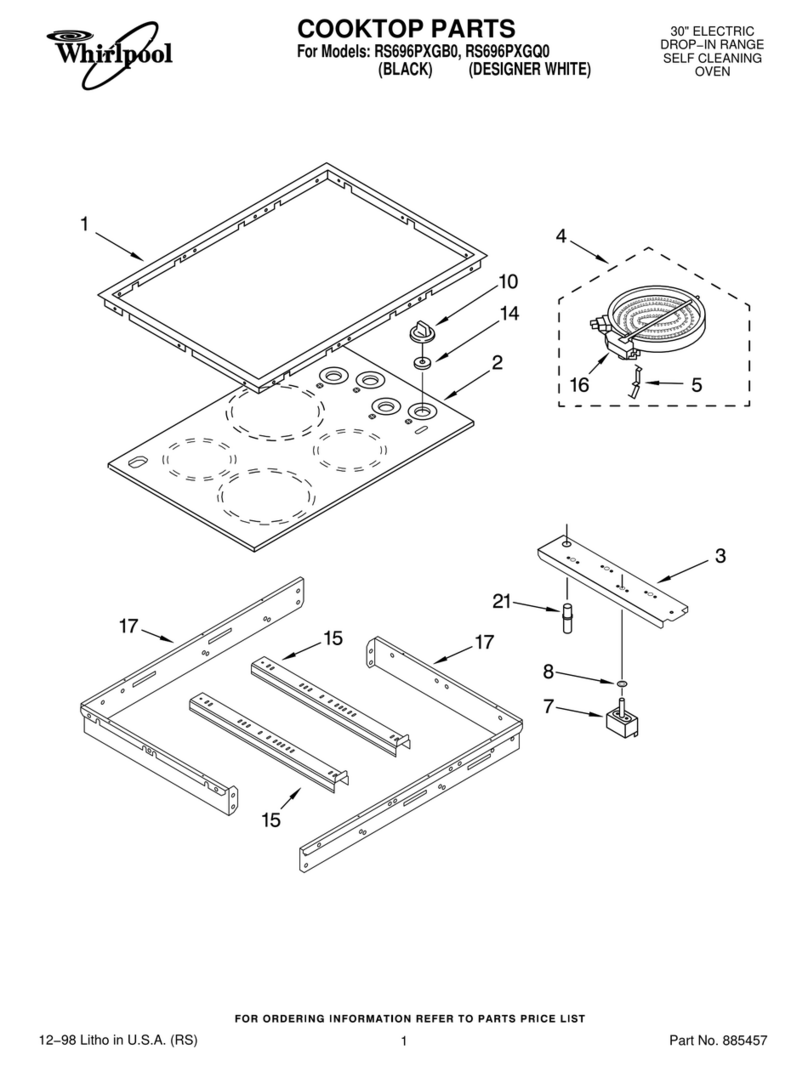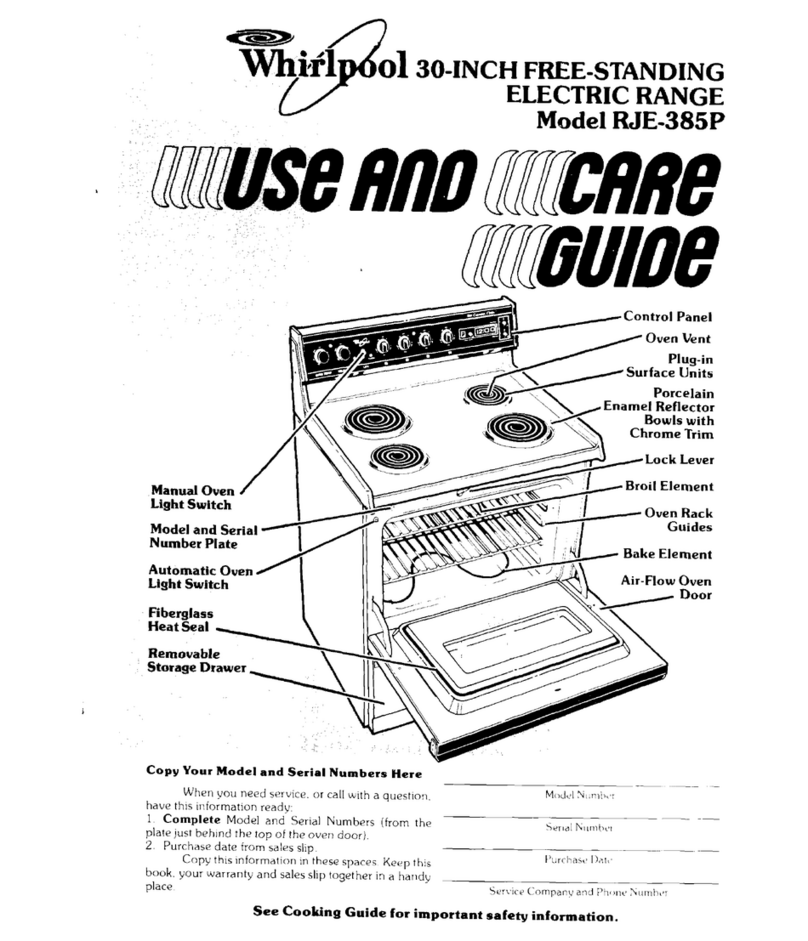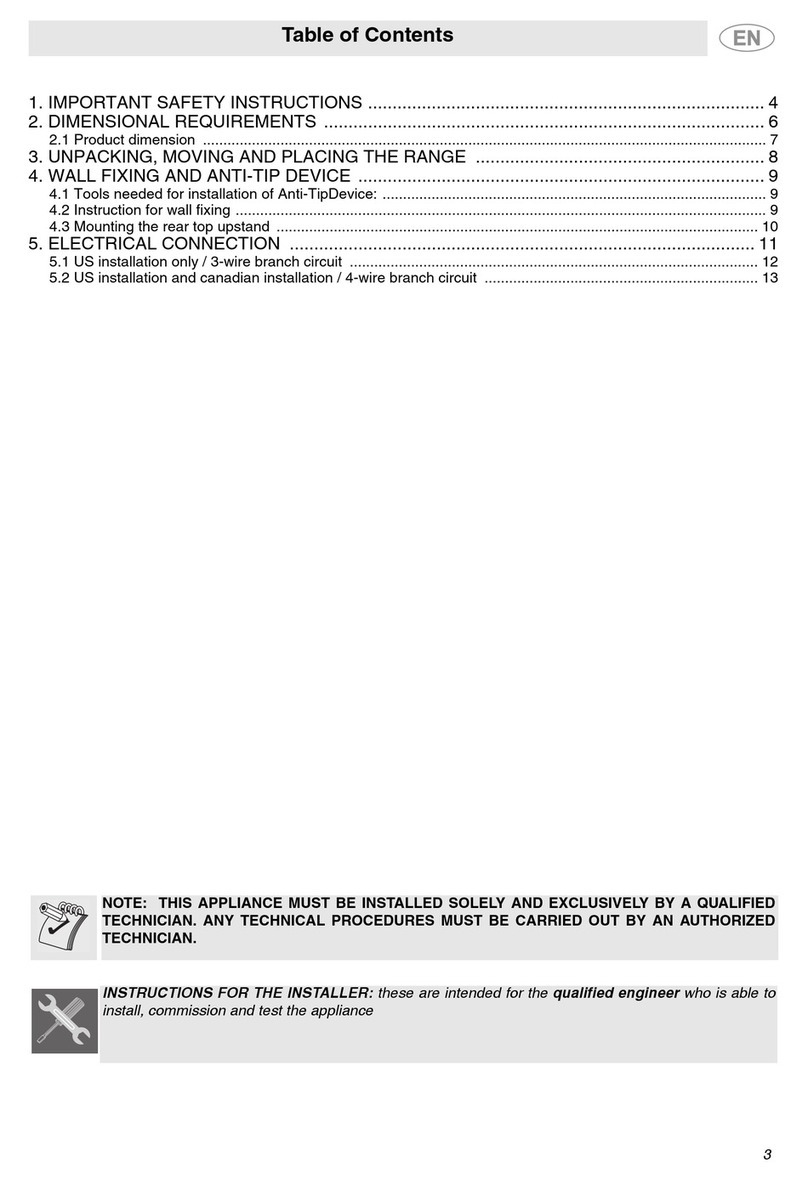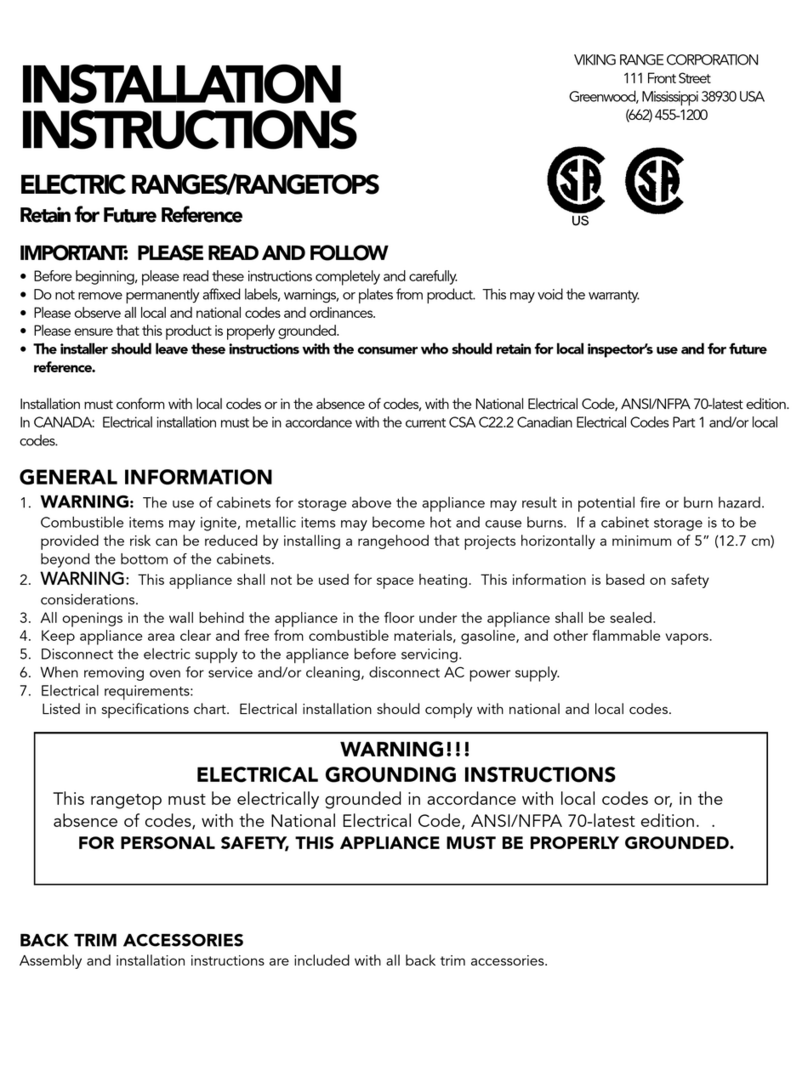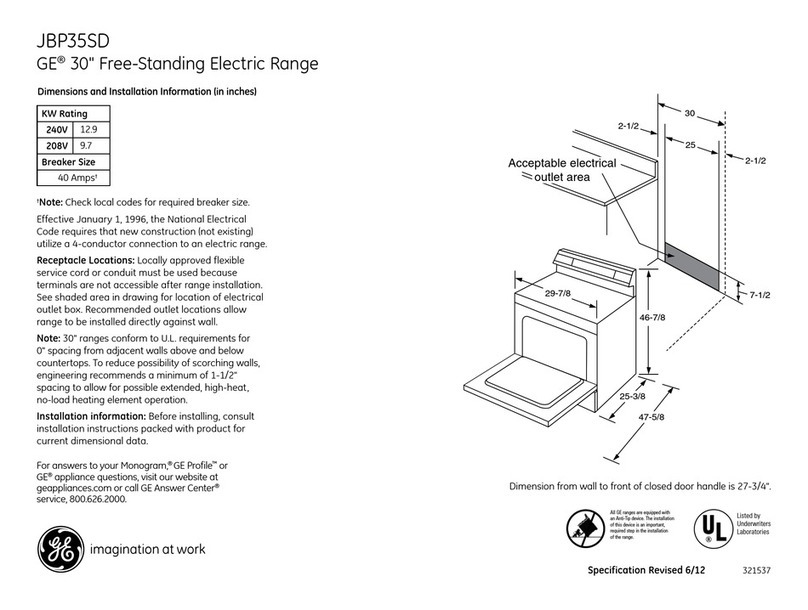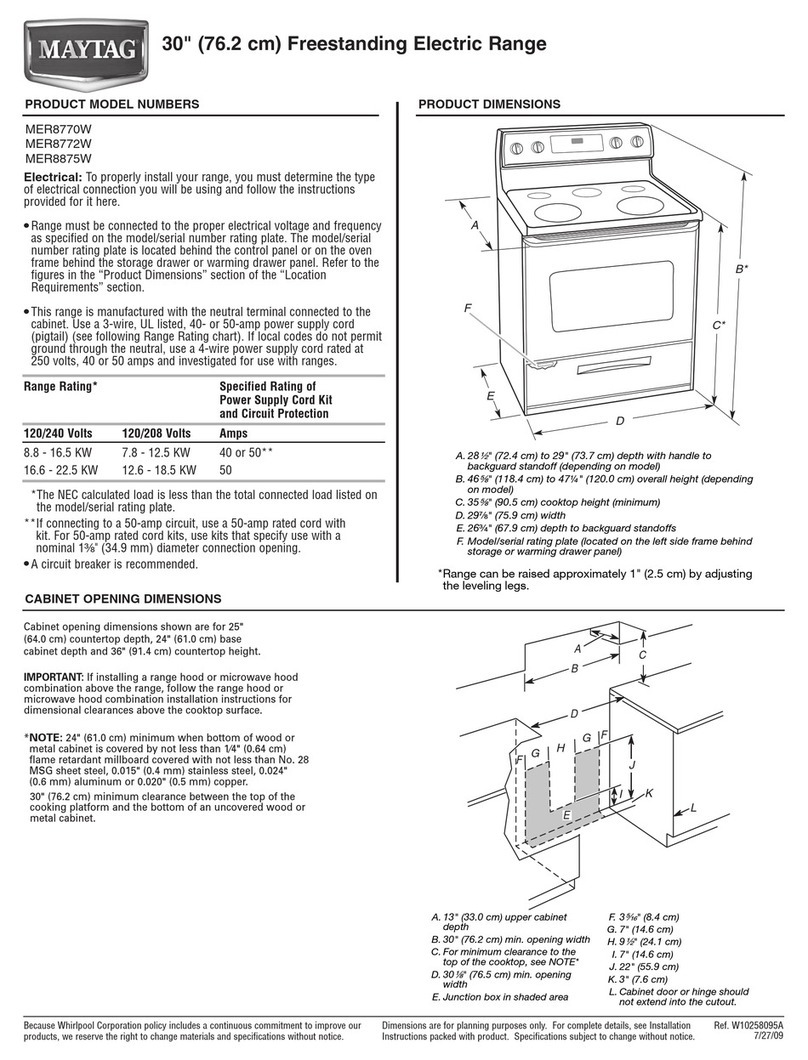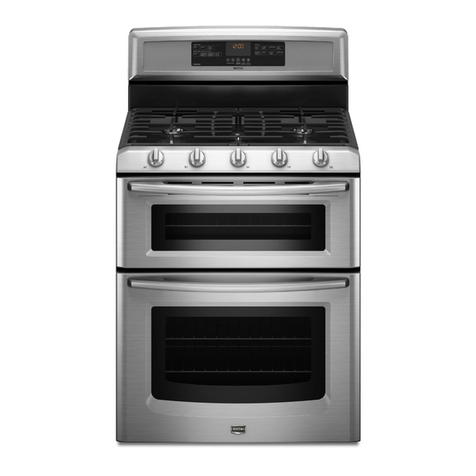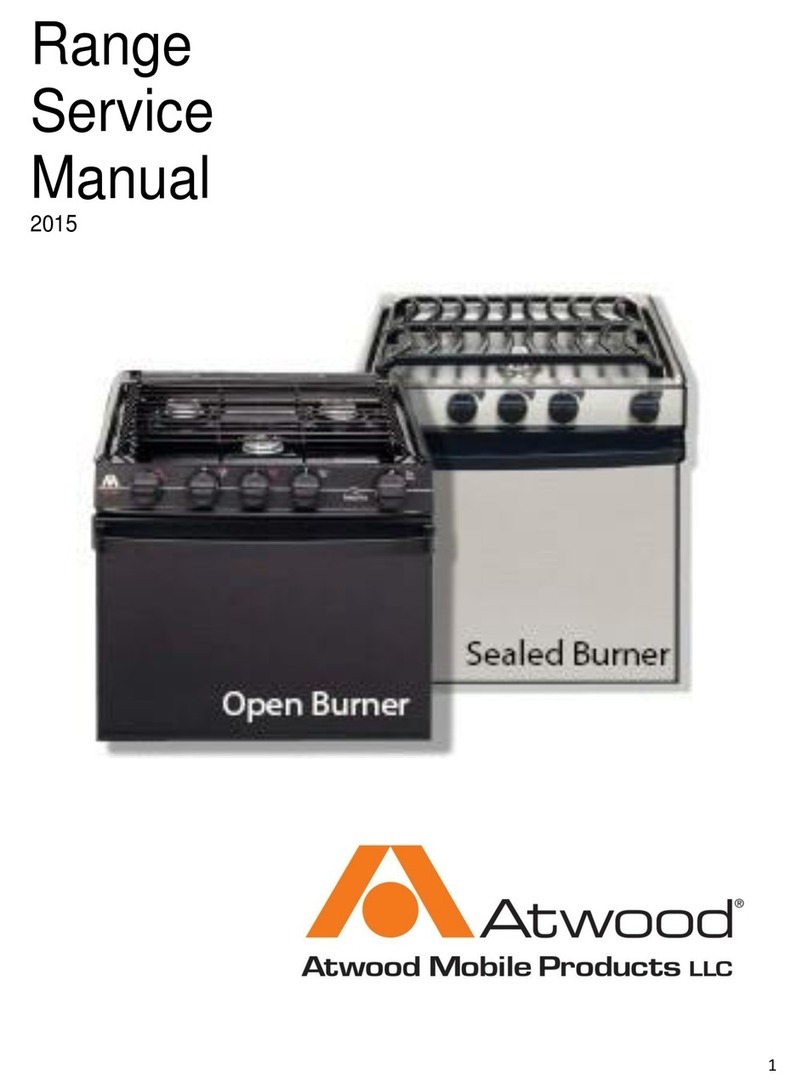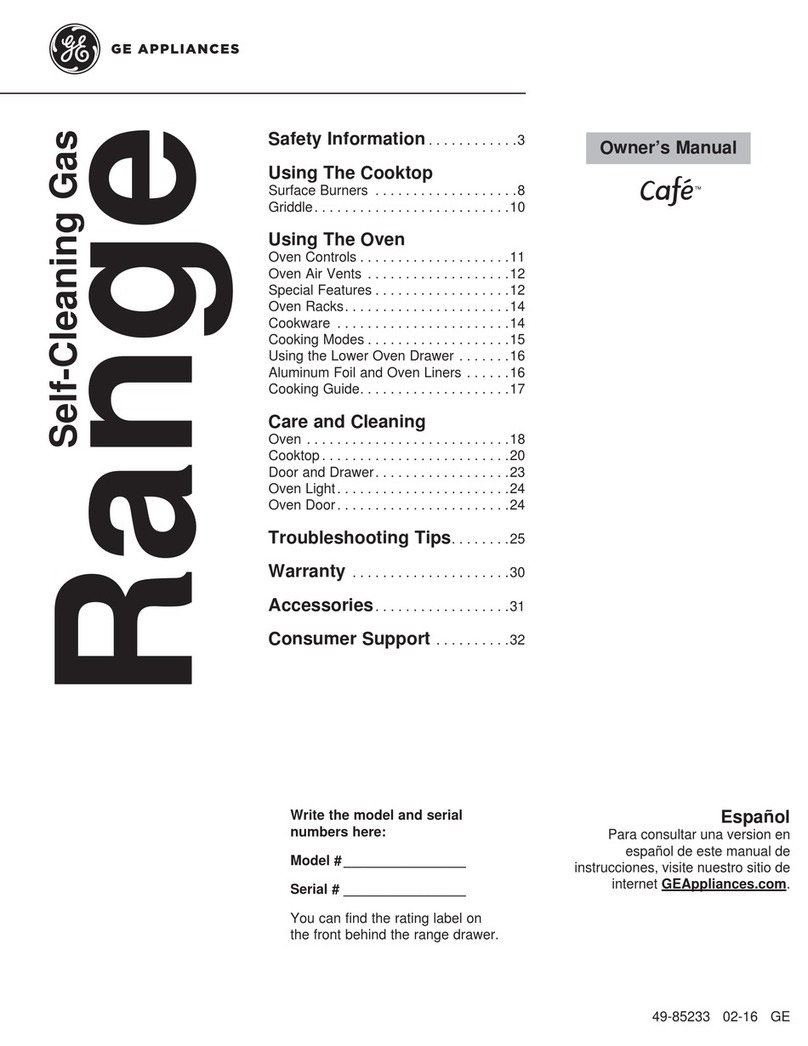Tecnoinox PPF8GG7 User manual

Fig.1 | Abb.1 | рис.1

PPF8GG7 PF_8GG7 PF_8SGG7 PF_8G7 PF_8V7 PFP_8GG7 PF_12GG7 PFP_12GG7 PF_12G7 PF_12V7 PF_X12GG7 PF_X12GGE7 PF_X12G7
Dimensioni esterne - External
dimensions - Außenmaße -
Dimensions extérieures -
Dimensiones externas. (mm)
L 800 800 800 800 800 800 1200 1200 1200 1200 1200 1200 1200
P 700 700 700 700 700 700 700 700 700 700 700 700 700
H 900 900 900 900 900 900 900 900 900 900 900 900 900
Forno gas, Gas oven, Gasabackofen,
Газовая печь, Four à gaz, Horno a
gas
7kW 7kW 7kW - - 7kW 7kW 7kW - - 7kW 7kW -
Forno elettrico, Electric oven,
Elektrischer Backofen, Электр. Печь,
Four électrique, Horno eléctrico
- - -
4.7 kW
400 V ~ 3N
50/60 Hz
5 kW
400 V ~ 3N
50/60 Hz
- - -
4.7 kW
400 V ~ 3N
50/60 Hz
5 kW
400 V ~ 3N
50/60 Hz
-
3 kW
230V ~ 1
50/60 Hz
6.3 kW
400 V ~ 3N
50/60 Hz
Sez.minima cavo alim., Supply cable
min.cross sec., Mindestquerschnitt
Speisungkabel, Мин. Разрез
электропровода, Sect. mini câble
alim., Sección mín. cable de alim.
- - - 5×1.5 mm2 5×1.5 mm2- - - 5×1.5 mm25×1.5 mm2- 5×1.5 mm25×1.5 mm2
Potenza nel piano - power on top -
Power auf - Puissance en haut -
Potencia en la parte superior.
1×9 kW
1×3.3 kW
2×4.5 kW
1×7.2 kW
4×7.2kW
1×3.3kW
2×4.5kW
1×7.2kW
1×3.3kW
2×4.5kW
1×7.2kW
1×3.3kW
1×4.5kW
1×7.2kW
2×3.3kW
2×4.5kW
2×7.2kW
1×3.3kW
3×4.5kW
1×7.2kW
2×3.3kW
2×4.5kW
2×7.2kW
2×3.3kW
2×4.5kW
2×7.2kW
2×3.3kW
2×4.5kW
2×7.2kW
2×3.3kW
2×4.5kW
2×7.2kW
2×3.3kW
2×4.5kW
2×7.2kW
Attacco gas - Gas inlet
connection – Gasanschluss -
Подсоединение газ - Arrivée
gaz - Entrada gas
G ½" EN 10226-
1
G ½" ISO 228-1
G ¾" EN 10226-1
G ¾" ISO 228-1
G ½" EN 10226-1
G ½" ISO 228-1
G ¾" EN 10226-1
G ¾" ISO 228-1
Morsetto equipotenziale - Unipotential earthing connection – Potentialausgleich - Эквипотенц. Клеммная коробка - Vis équipotentiel - Tornillo equipotencial
Entrata cavo elettrico - Power supply cable inlet – Netzkabeleingang - Вход электр. Провода - Entrée câble électrique - Entrada cable eléctrico
Fig.2 | Abb.2 | рис.2 Fig.3 | Abb.3 | рис.3

Fig.4 | Abb.4 | рис.4
Fig.5 | Abb.5 | рис.5 Fig.6 | Abb.6 | рис.6 Fig.7 | Abb.7 | рис.7
Fig.8 | Abb.8 | рис.8 Fig.9 | Abb.9 | рис.9 Fig.10 | Abb.10 | рис.10 Fig.11 | Abb.11 | рис.11
Fig.12 | Abb.12 | рис.12 Fig.13 | Abb.13 | рис.13 Fig.14 | Abb.14 | рис.14

05/2011 DATI TECNICI - TECHNISCHE DATEN - TECHNICAL DATA - DONNEES TECHNIQUES - DATOS TÉCNICOS 5410.496.00
T1. Tabella ugelli – Düsentabelle - Nozzle table - Tableau des injecteurs - Tabla de los inyectores - Таблица форсунок
CATEGORIA
Kat.;Cat. P [mbar] GAS Dim
1/100 mm
Bruciatore (Brenner, burner, brûleur, quemador) ½ PIASTRA * PIASTRA * FORNO ** FORNO XL **
3.3 kW 4.5 kW 7.2 kW 4.5 kW 9 kW 7 kW 7 kW
2E;2E+;2H 20 G20
MAX 130 155 200 155 220 195 200
MIN REG. REG. REG. REG. REG. REG. REG. (CLOSE)
PILOTA 35 35 35 35 35 35 27
H [mm] 10 14 14 12 11 CLOSE 25
3+;3B/P+ 28-30/37 G30/G31
MAX 85 105 130 105 140 130 135
MIN 55 65 80 65 85 80 REG. (CLOSE)
PILOTA 20 20 20 20 25 20 14
H [mm] MAX MAX MAX MAX MAX 7 30
3B/P 37 G30/G31
MAX 82 100 125 100 135 120 125
MIN 50 55 70 55 70 60 REG. (CLOSE)
PILOTA 20 20 20 20 25 20 14
H [mm] MAX MAX MAX MAX MAX 7 30
3B/P 50 G30/G31
MAX 80 90 115 90 130 115 120
MIN 50 55 70 55 70 60 REG. (CLOSE)
PILOTA 20 20 20 20 25 20 14
H [mm] MAX MAX MAX MAX MAX 7 30
2LL 20 G25
MAX 150 170 225 170 250 220 220
MIN REG. REG. REG. REG. REG. REG. REG. (CLOSE)
PILOTA 35 35 35 35 35 35 27
H [mm] 9 12 12 10 9 CLOSE 25
2L 25 G25
MAX 135 165 215 165 240 210 210
MIN REG. REG. REG. REG. REG. REG. REG. (CLOSE)
PILOTA 35 35 35 35 35 35 27
H [mm] 9 12 12 10 9 CLOSE 25
2S 25 G25.1
MAX 140 165 220 165 240 220 210
MIN REG. REG. REG. REG. REG. REG. REG. (CLOSE)
PILOTA 35 35 35 35 35 35 27
H [mm] 9 10 11 9 9 CLOSE 20
Brennerdüse, Burner nozzle, Injecteur du brûleur, Inyectores de los quemadores, Макс поз.
Kleinstellschraube, Min.adjusing screw, Vis de réglage minimum, Tornillo de regulación del mínimo, Мин.поз.
Zündbrennerdüse, Pilot burner nozzle, Injecteur de la veilleuse, Inyectores del piloto, Пламя.
H Aria primaria, Primärluft Abstand, Primary air, Air primaire, Aire primario, Первычный воздух
* Warmhalteplatte, Heating plate, Plaque chauffante, Plancha, Плитка
** Backofen, Oven, Four, Horno, Печь.

05/2011 DATI TECNICI - TECHNISCHE DATEN - TECHNICAL DATA - DONNEES TECHNIQUES - DATOS TÉCNICOS 5410.496.00
Cat. (kat.) P Paese (land - country - pays - país)
I2E 20 mbar LU,PL
I2E+ 20/25 mbar BE
I3+ 28-30/37 mbar BE,LU
I3B/P 28-30 mbar NL,NO,CY,MT
II2E+3+ 20/25, 28-30/37 mbar BE,FR
I3B/P 37 mbar PL
II2ELL3B/P 20, 50 mbar DE
II2H3+ 20, 28-30/37 mbar ES,GB,GR,IE,IT,PT,SK
II2H3B/P 20, 28-30 mbar BG,DK,EE,FI,LV,LT,CZ,SE,SI
II2H3B/P 20, 50 mbar AT,CH
II2L3B/P 25, 28-30 mbar NL
II2S3B/P 25, 30 mbar HU
II2S3B/P 25, 50 mbar HU
PF_8G7 PF_8GG7 PF_8SG7 PF_12G7 PF_12V7 PF_12GG7 PFP_8GG7 PFP_12GG7 PPF_8GG7 PF_X12G7 PF_X12GG_7
Qn [kW]
19.5 26.5 35.8 30 30 37 22 29.8 16 30 37
Consumo *
Metano (G20) m3/h
(Hi = 9.45 kWh/m3) 2.06 2.8 3.79 3.17 3.17 3.92 2.33 3.15 1.69 3.17 3.92
Metano (G25-G25.1) m3/h
(Hi = 8.13 kWh/m3) 2.40 3.26 4.40 3.69 3.69 4.55 2.71 3.67 1.97 3.69 4.55
GPL (G30) kg/h
(Hi = 12.68 kWh/kg) 1.54 2.09 2.82 2.37 2.37 2.92 1.73 2.35 1.26 2.37 2.92
* Gasverbrauch - Gas consumption - Consommation du gaz - Consumo de gas - Расход газа

IT - 1 5410.496.00
Parte 1 - Installazione
CUCINE A GAS
Avvertenze Generali
L'apparecchio descritto nel presente libretto è costruito nel rispetto dei
requisiti delle norme UNI EN 203,UNI EN 437, EN 60335-1, EN60335-
2-36 e EN55014. Quest’apparecchiatura è concepita unicamente per la
cottura degli alimenti, ogni altro tipo d’impiego è da ritenersi improprio;
è destinata solo ad uso professionale da parte di personale qualificato.
L'apparecchio deve essere utilizzato esclusivamente sotto sorveglianza.
Si consiglia inoltre, un controllo annuale da eseguirsi a cura di
professionisti qualificati.
Disattivare l'apparecchiatura in caso di guasto o cattivo funzionamento.
Si consiglia di installare l’apparecchio sotto ad una cappa aspirante per l’evacuazione dei vapori prodotti durante la cottura.
Prestare attenzione durante il funzionamento poiché le superfici di cottura sono molto calde.
Nei modelli PP.. e PFP.. la piastra raggiunge la temperatura massima di 420°C.
L'allacciamento, l'installazione e la manutenzione dell'apparecchiatura devono essere eseguiti a cura di personale qualificato secondo le norme
e le prescrizioni vigenti nel paese, in conformità alle presenti istruzioni.
Caratteristiche dell’apparecchio
Il presente libretto d’istruzioni per l’installazione ed uso si riferisce alle
cucine a gas della categoria II2H3+.
La targhetta matricola in poliestere autoadesivo “T” fig.7 si trova dietro al
pannello portacomandi (all'interno dell'apparecchio).
Essa contiene i seguenti dati: per es.:
PF_8GG7
xxx
II2H3+
xxx
26,5
A1
UNI EN 203-1
G30 28-30/37 mbar
G20 20 mbar
G30 [Kg/h] 2,09
G20 [m
3
/h] 2,80
Modello
Numero di serie
Categoria
Consumo
Base di prova
Pressione di collegamento
Anno di fabbricazione
Portata termica nominale [kW]
Tipo di costruzione
La targhetta supplementare è in poliestere autoadesivo ed è applicata
vicino alla targhetta matricola, essa contiene tutte le informazioni sulla
predisposizione dell’apparecchio. L’attacco per il collegamento alla rete
del gas “ ” fig.1 corrisponde alle prescrizioni EN 10226-1 e ISO 228-1
con attacco ø½” o ¾”, esso è situato nella parte inferiore della macchina.
La struttura dell’apparecchio è d’acciaio inox; i bruciatori sono in ghisa e
in acciaio inox quello della piastra. Tutti i modelli sono dotati di piedini
regolabili in altezza. La conduttura principale del gas è in acciaio zincato.
Le condutture di collegamento dal rubinetto al bruciatore sono in rame.
Modello N°bruciatori Fornelli Forno
PPF8GG7 1 9kW 7kW
PF_8GG7 4 1×3.3kW+2×5.5kW +
1×7.2kW 7kW
PF_8SGG7 4 4 × 7.2kW 7kW
PF_8G7 4 1×3.3kW+2×5.5kW +
1×7.2kW 4.7kW
PFP_8GG7 2 + 1 1×3.3kW+1×5.5kW+1×7.2kW
7kW
PFP_12GG7 4 + 1 1×3.3kW+2×4.5kW+1×7.2kW
7kW
PF_12GG7 6 2×3.3kW+2×4.5kW+2×7.2kW
7kW
PF_12G7 6 2×3.3kW+2×4.5kW+2×7.2kW
4.7kW
PF_12V7 6 2×3.3kW+2×4.5kW+2×7.2kW
5kW
PFX_12GG7 6 4×5.5kW + 2×9kW 7kW
PF_X12GGE7 6 2×3.3kW+2×4.5kW+2×7.2kW
3kW
7kW
PF_X12G7 6 2×3.3kW+2×4.5kW+2×7.2kW
6.3kW
Interporre tra l'apparecchio e la rete di distribuzione gas un
rubinetto d’intercettazione. Interporre tra l'apparecchio e la rete di
alimentazione elettrica un interruttore elettrico onnipolare.
Collegamento alla rete gas
Prima di procedere all’installazione dell’apparecchiatura è
indispensabile farsi rilasciare dall’ente erogatore del gas il
nullaosta all’installazione, raffrontare poi i dati relativi alle
predisposizioni dell’apparecchiatura (targhetta caratteristiche)
con l’erogazione in loco.
Togliere l'imballo dall'apparecchiatura, rimuovere la pellicola protettiva
e, se necessario eliminare le tracce di colla con l'ausilio di un idoneo
solvente. Si raccomanda di smaltire l'imballo secondo le norme vigenti
(per maggiori dettagli fare riferimento al capitolo "ECOLOGIA E
AMBIENTE”). Prima di collegare l’apparecchio alla rete del gas,
controllare sulla targhetta matricola se l’apparecchio è predisposto e
collaudato per il tipo di gas erogato. Qualora il tipo di gas riportato in
targhetta non corrispondesse al tipo di gas erogato, consultare il
paragrafo “TRASFORMAZIONE ED ADATTAMENTO”. Il collegamento
alla rete di distribuzione del gas deve avvenire con tubi metallici, di
diametro adeguato e con interposizione di un rubinetto
d’intercettazione omologato. Se vengono impiegati tubi flessibili, questi
devono essere di acciaio inossidabile secondo le norme vigenti. Durante
l'installazione sono da osservare e rispettare tutte le norme vigenti quali:
Norma di sicurezza UNI-CIG 8723, legge nr.46 del 5 marzo 1990 e
circolare nr.68.
Norme regionali e/o locali quali regolamento edilizio.
Prescrizioni e norme dell'azienda erogatrice dell'energia elettrica.
Norme antinfortunistiche vigenti.
Prescrizioni antincendio.
Relative norme CEI.
Si consiglia d’installare l'apparecchio in un ambiente ben areato e sotto
una cappa aspirante per l'evacuazione dei fumi e vapori prodotti
durante la cottura. Tutti i modelli sono dotati di morsetto equipotenziale
posizionato nella parte posteriore dell’apparecchiatura “ ” (fig.1). Le
apparecchiature con forno elettrico sono dotate di passacavo “ ” (fig.1).
L’apparecchio può essere installato da solo o in batteria. Rispettare la

IT - 2
distanza minima di 80mm tra apparecchiatura ed eventuali pareti in
materiale infiammabile, divisori, mobili da cucina o apparecchiature
adiacenti. Le superfici a contatto con l’apparecchiatura dovranno essere
rivestite in materiale isolante termico di tipo non combustibile.
L’apparecchiatura, e in particolar modo il cavo d’alimentazione, non
deve essere sistemata vicino a fonti di calore, l’ambiente circostante
all’apparecchiatura non deve superare la temperatura di 50°C. Ad
installazione avvenuta procedere al controllo di tenuta dei raccordi. Per
individuare eventuali perdite si consiglia l’utilizzo di prodotti a base
schiumosa non corrosiva, tipo spray cerca fughe.
Durante la prova di tenuta non usare fiamme libere!
Il costruttore non si assume nessun impegno di garanzia per danni che
accadessero a causa dell’inosservanza delle istruzioni d’installazione
d’uso, o d’utilizzo improprio. Non si assume inoltre alcun impegno di
garanzia per un allacciamento non eseguito in conformità alle norme
vigenti e le prescrizioni antincendio.
Evacuazione dei fumi di combustione
Non è necessario collegare ad un camino le apparecchiature, se ne consiglia però l'installazione sotto cappa aspirante.
Controllo della pressione
La pressione di rete dovrà rispettare quanto segue.
GPL
AMMESSO Tra 20/25 e 35/45 mbar
NON AMMESSO Inf. a 20/25 sup. a 35/40 mbar
METANO
H
AMMESSO Tra 17 e 25 mbar
NON AMMESSO Inf. a 17 e sup. di 25 mbar
Qualora la pressione di rete sul posto d’installazione non sia come sopra
riportato, avvisare l’ente preposto alla distribuzione e non procedere alla
messa in funzione prima che la causa non sia stata individuata ed
eliminata.
La pressione di rete è rilevabile attraverso un manometro ad U
(definizione min. 0.1mbar), collegabile alla presa di pressione “P” fig.11
dietro il cruscotto.
1. Rimuovere il cruscotto portacomandi.
2. Togliere la vite e rondella di tenuta “Y” fig.11 dalla presa di
pressione, collegare il manometro.
3. Mettere in funzione l’apparecchio secondo le istruzioni accluse e
controllare se la pressione riscontrata rientra nel campo delle
pressioni ammesse.
4. Scollegare il manometro e riposizionare la vite e rondella di tenuta
nella presa di pressione.
5. Rimontare il cruscotto.
Collegamento alla rete elettrica (modelli G7 – V7)
Prima di procedere al collegamento alla rete elettrica, verificare i dati
tecnici riportati sulla targhetta caratteristiche. L’apparecchio è fornito
senza cavo d’alimentazione.
L’installatore deve provvedere al collegamento previa interposizione di
un interruttore principale, che oltre ad essere facilmente accessibile,
deve interrompere l’erogazione d’energia in modo onnipolare e i
contatti in apertura devono avere tra loro una distanza minima di
almeno 3 mm per polo.
Il cavo d’alimentazione non dovrà presentare caratteristiche inferiori a
H07 RN-F e dovrà avere una sezione minima vedi tabella, non dev’essere
posizionato vicino a fonti di calore e l’ambiente circostante non deve
superare una temperatura di 50°C.
Per accedere alla morsettiera “M” fig.6 rimuovere lo zoccolo “N” fig.6.
Seguendo le indicazioni sullo schema elettrico, collegare i conduttori del
cavo d’alimentazione alla morsettiera. È indispensabile collegare
l’apparecchiatura ad un’efficace presa di terra.
A tale scopo sulla morsettiera vi è un morsetto con il simbolo al quale
va allacciato il conduttore di terra. Far scorrere il cavo vicino alla
morsettiera, tenere inoltre il cavo in appoggio sul fondo infine bloccarlo
con l’apposito pressacavo.
L’apparecchiatura deve inoltre essere inclusa in un sistema
equipotenziale.
Il collegamento viene effettuato mediante un morsetto equipotenziale
contrassegnato dal simbolo posto nella parte posteriore
dell’apparecchio.
Il filo equipotenziale deve avere una sezione di 10 mm2.
Il costruttore declina ogni responsabilità nel caso di danni provocati
da errata installazione, impropria manutenzione ed inosservanza delle
prescrizioni di sicurezza!

IT - 3
Parte 2 – Trasformazione ed adattamento
Per la trasformazione da un tipo di gas ad un altro, per es. da metano a
GPL, si rende necessaria la sostituzione degli ugelli del bruciatore
principale, del by-pass e del pilota. Tutti gli ugelli sono contrassegnati da
un numero che indica il diametro in 1/100 di mm e forniti in dotazione
in un sacchetto.
Dopo ogni trasformazione o adattamento, sottoporre l’apparecchio ad
una prova delle funzioni e aggiornare la targhetta supplementare in
base alla trasformazione o adattamento effettuato.
Si raccomanda che tutti i lavori relativi all’allacciamento,
all’installazione ed alla manutenzione dell’apparecchio siano eseguiti
esclusivamente da personale qualificato ed in osservanza di tutte le
relative prescrizioni!
Bruciatore piano cottura, ugelli e regolazione aria
BRUCIATORE:
Sfilare le manopole.
Togliere il cruscotto comandi svitando le viti di fissaggio poste nella
parte inferiore dello stesso.
Sostituire l’ugello “U” (fig.9) con quello adatto al nuovo tipo di gas
vedi “MAX”nella tabella ugelli T1 sezione Dati tecnici.
REGOLAZIONE ARIA:
Svitare la vite di fissaggio “X” (fig.9)
Regolare l’aria primaria muovendo la boccola fino alla distanza “H”
indicata nella tabella ugelli T1 sezione Dati tecnici.
Avvitare le viti di fissaggio.
PILOTA:
Svitare il dado di chiusura “Z” (fig.8)
Svitare e sostituire l’ugello del pilota “D” (fig.8) con quello indicato
per il nuovo tipo di gas nella tabella ugelli T1 sezione Dati
tecnici.
Rimontare e serrare il dado di chiusura.
MINIMO:
Sostituire o regolare l'ugello by-pass del minimo "Um" (fig.11) in
base alle indicazioni della tabella ugelli T1 sezione Dati tecnici.
Rimontare il cruscotto comandi.
Rimontare la manopola.
Bruciatore tuttapiastra (modelli PP../PFP..)
BRUCIATORE:
Sfilare le manopole.
Togliere il cruscotto comandi svitando le viti di fissaggio poste nella
parte inferiore dello stesso.
Sostituire l’ugello “U” (fig.10) con quello adatto al nuovo tipo di gas
vedi “MAX”nella tabella ugelli T1 sezione Dati tecnici.
REGOLAZIONE ARIA:
Svitare la vite di bloccaggio “X” (fig.10)
Regolare l’aria primaria muovendo la staffa “S” (fig.10) fino alla
distanza “H” indicata nella tabella ugelli T1 sezione Dati tecnici.
Avvitare la vite di bloccaggio.
PILOTA:
Svitare il dado di chiusura “Z” (fig.8)
Svitare e sostituire l’ugello del pilota “D” (fig.8) con quello indicato
per il nuovo tipo di gas nella tabella ugelli T1 sezione Dati
tecnici.
Rimontare e serrare il dado di chiusura.
MINIMO:
Sostituire o regolare l'ugello by-pass del minimo "Um" (fig.11) in
base alle indicazioni della tabella ugelli T1 sezione Dati tecnici.
Rimontare il cruscotto comandi.
Rimontare la manopola.
Bruciatore del forno (modelli GG7)
Per sostituire l’ugello del bruciatore del forno,del pilota e regolare l'aria
primaria seguire le indicazioni qui riportate:
BRUCIATORE: PF PFX
Rimuovere lo zoccolo del forno "N" (fig.6).
Svitare e sostituire l’ugello con quello adatto al nuovo tipo di gas
vedi “MAX” nella tabella ugelli T1 sezione Dati tecnici.
REGOLAZIONE ARIA:
Allentare la vite di fissaggio “X” (fig.14)
Regolare l’aria primaria muovendo la boccola fino alla distanza “H”
(fig.14) indicata nella tabella ugelli T1 sezione Dati tecnici.
Bloccare la boccola serrando la vite di fissaggio "X" (fig.14).
PILOTA: PF PFX
Svitare il dado di chiusura "X" (fig.12)
Sostituire l’ugello del pilota “D” (fig.12) con quello indicato per il
nuovo tipo di gas nella tabella ugelli T1 sezione Dati tecnici.
Rimontare e serrare il dado di chiusura "X" (fig.12).
Rimontare lo zoccolo del forno “N” (fig.8).
MINIMO:
Sfilare le manopole.
Togliere il cruscotto comandi svitando le viti di fissaggio poste nella
parte inferiore dello stesso.
Svitare e sostituire o regolare l'ugello by-pass del minimo "Um"
(fig.13) in base alle indicazioni della tabella ugelli T1 sezione Dati
tecnici.
Rimontare il cruscotto comandi.
Rimontare la manopola.
N.B. Se viene rimosso il fondo della camera del forno, quest'ultimo deve
essere riposto nella posizione di origine.

IT - 4
Parte 3 - Uso
Messa in funzione
IMPORTANTE:
Il forno alla prima accensione emana cattivi odori dovuti ai residui di
produzione quali grassi, oli e resina.
Quando si usa per la prima volta il forno è necessario far funzionare
l'apparecchio a vuoto, alla massima temperatura per almeno un’ora.
Trascorso questo tempo il forno è pronto all’uso.
CONSIGLI PER L'USO:
È buona norma, per la riuscita dei vostri piatti, non introdurre mai le
pietanze a forno freddo, bensì attendere che esso abbia raggiunto la
temperatura da voi prescelta.
Non rivestire mai le pareti del forno con fogli d’alluminio, soprattutto la
parte inferiore del vano di cottura.
Pulire il forno dopo ogni uso.
Accensione e spegnimento dei bruciatori
BRUCIATORI PIANO COTTURA
Premere e ruotare la manopola “A” (fig.4) dalla posizione “ ” a " "
mantenendola premuta. Con un accenditore “W” (fig.6) o fiammifero
innescare la fiamma. Ad accensione avvenuta mantenere la manopola
premuta per circa 10 secondi (contare fino a venti); si da modo così alla
termocoppia di riscaldarsi e quindi di tenere aperta la valvola di
sicurezza.
PIASTRA RISCALDANTE
Nei modelli con piastra sollevare il coperchio “C” (fig.7) e seguire le
istruzioni precedenti. Per i modelli PP../PFP.. l’accensione del pilota
avviene azionando ripetutamente il tasto “B” (fig.4).
NOTA: qualora il dispositivo piezoelettrico fosse inutilizzabile,
l'accensione può avvenire anche manualmente con un fiammifero
oppure con accenditore gas.
Per ottenere l'accensione del bruciatore principale, si ruota
ulteriormente la manopola fino alla posizione desiderata, osservare i
valori in tabella.
Spento Acc. Fiamma pilota Bruciatore MAX Bruciatore min
SPEGNIMENTO DEL BRUCIATORE:
Ruotare la manopola dalla posizione in cui si trova fino a " ".
SPEGNIMENTO DELL'APPARECCHIO:
Ruotare le manopole fino alla posizione “ ”.
Accensione e spegnimento del forno elettrico (solo modelli G7)
ACCENSIONE:
Il sistema di funzionamento delle resistenze è controllato da un
selettore a quattro posizioni, mentre la temperatura all’interno della
camera è controllata da un termostato (60-270°C).
Il selettore consente di scegliere il tipo di riscaldamento più idoneo
inserendo in modo appropriato gli elementi riscaldanti. Ruotare la
manopola “C” (fig.3) selettore di comando delle resistenze su una
delle posizioni d’utilizzo. L’accensione della lampada spia verde “E”
(fig.3) indica che la macchina è sotto tensione.
Ruotare la manopola “D” (fig.3) del termostato fino alla gradazione
corrispondente la temperatura di cottura desiderata. L’accensione
della spia arancione “F” (fig.3) segnala il funzionamento delle
resistenze di riscaldamento.
Tutte le cotture devono essere effettuate con la porta del forno
chiusa.
Posizioni manopola “C”
0 Posizione di spento
Elementi riscaldanti inferiore e superiore
Elemento riscaldante superiore “Grill”
Elemento riscaldante inferiore
Posizioni manopola “D”
0 60°C 100°C 140°C 180°C 220°C 270°C
SPEGNIMENTO DEL FORNO ELETTRICO:
Riportare le manopole “C-D” sulla posizione 0. Disinserire l’interruttore
elettrico installato a monte dell’apparecchiatura.
Accensione del forno ventilato (solo mod. PF_V7)
Ruotare la manopola “D” (fig.1) termostato fino alla gradazione
corrispondente la temperatura di cottura desiderata. L’accensione della
lampada spia verde “E” (fig.1) indica che la macchina è sotto tensione e
le ventole in funzione. L’accensione della spia arancione “F” (fig.1)
segnala il funzionamento delle resistenze di riscaldamento.
Posizioni manopola D (PF_V7)
0 100 °C 150 °C 200 °C 250 °C 295 °C
Termostato di sicurezza (solo modelli G7)
In caso di surriscaldamento, a causa d’utilizzo non conforme
dell'apparecchio o per difetto di qualche componente, interviene il
termostato di sicurezza “G” (fig.2) che interrompe automaticamente
l’alimentazione degli elementi riscaldanti. Quando interviene questo
dispositivo, spegnere il forno, interrompere l’alimentazione elettrica
dell’apparecchiatura, chiudere il rubinetto del gas posto a monte
dell’apparecchiatura e avvisare il servizio assistenza.

IT - 5
Accensione e spegnimento del forno gas
ACCENSIONE:
1. Aprire la porta del forno
2. Premere e ruotare la manopola “O” (fig.4) della valvola termostatica
dalla posizione “ ” a " " mantenendola premuta.
3. Contemporaneamente premere più volte l’accenditore
piezoelettrico “B” (fig.4), per innescare la fiamma pilota.
4. Ad accensione avvenuta mantenere la manopola premuta per circa
10 secondi (contare fino a 20); si da modo così alla termocoppia di
riscaldarsi e quindi di tenere aperta la valvola di sicurezza;
5. Controllare attraverso il foro sul coperchio d’ispezione “I” (fig.5)
l’avvenuta accensione.
6. Posizionare successivamente la manopola sulla temperatura
desiderata.
Il bruciatore é dotato di una valvola di sicurezza che blocca
l'erogazione del gas in caso di spegnimento accidentale della fiamma.
SPEGNIMENTO DEL FORNO GAS:
Riportare la manopola alla posizione “ ” premendola leggermente per
superare il fermo della posizione minimo.
Comportamento in caso di prolungata inattività
Chiudere il rubinetto d’intercettazione gas e l’interruttore principale a
monte dell’apparecchiatura.
Pulire accuratamente l’apparecchio seguendo le istruzioni e asciugarlo
con cura.
Comportamento in caso di guasti
I guasti non sempre dipendono dalla qualità dei componenti, che nel
nostro caso sono d’ottima fattura, essi possono essere, da polvere o
sporco che penetra nei componenti funzionali.
In qualsiasi caso in cui si sospetta un funzionamento anormale,
CHIUDERE SEMPRE il rubinetto d’intercettazione dell’alimentazione
Gas ed avvisare il servizio d’assistenza autorizzato.
Non improvvisarsi manutentori, la manomissione dell'apparecchio
implica il decadimento della garanzia.
Controllo del funzionamento
Prima di consegnare l’apparecchio all’utilizzatore eseguire i seguenti
controlli:
PORTATA TERMICA
Controllare che il tipo di gas erogato e la pressione corrisponda a
quanto riportato sulla targhetta. In caso contrario procedere ad una
trasformazione o ad un adattamento; in questo caso consultare il
paragrafo “Trasformazione ed adattamento”.
Controllare che siano installati gli ugelli corretti.
Allo scopo consultare la tabella ugelli T1 sezione Dati tecnici e
controllare la corrispondenza con quelli montati sull’apparecchiatura.
Per un controllo supplementare della portata, si può verificare il
consumo di gas con il metodo volumetrico: mettere in funzione il
bruciatore, dopo ca. 10 minuti (condizione a regime) controllare se il
flusso di gas (in m3/h oppure in kg/h) rilevato corrisponde a quanto
riportato nella tabella ugelli T1 sezione Dati tecnici.
ASPETTO DI FIAMMA E FLUSSO DELL'ARIA PRIMARIA
La fiamma deve essere di colore blu, non deve evidenziare punte gialle e
deve essere stabile alla base.
L’aspetto della fiamma con colore tendente al giallo evidenzia un’errata
regolazione dell’aria primaria. Se l’aria primaria è in eccesso, la fiamma è
corta e tende a staccarsi dal bruciatore.
Il controllo dell’aspetto della fiamma deve essere effettuato anche dopo
ca. 15 minuti di funzionamento alla potenza massima. La fiamma deve
restare stabile anche dopo un passaggio veloce da minimo a massimo.
ISTRUZIONI PER L'UTENTE
L’utente deve essere debitamente istruito sull’impiego corretto, sulle
funzioni e sull’uso dell’apparecchio. Si fa presente, che modifiche
all’ambiente d’installazione, che può influenzare l’apporto d’aria
comburente, comporta un nuovo controllo del funzionamento
dell’apparecchio. Al termine dei controlli sottoporre l’apparecchio ad
una prova di tenuta.

IT - 6
Parte 4 – Manutenzione e pulizia
Sostituzione di parti
La sostituzione di parti difettose, deve essere eseguita esclusivamente
da personale abilitato. Prima di iniziare qualsivoglia lavoro scollegare
l’apparecchio dalla rete di distribuzione del gas e quella elettrica. Dopo
aver tolto il pannello comandi tutte le parti funzionali dell'apparecchio
diventano facilmente accessibili.
I pezzi di ricambio sono da richiedere esclusivamente al costruttore
o da un rivenditore autorizzato.
Pulizia e cura
La pulizia deve essere effettuata solamente ad apparecchio
raffreddato.
Si ricorda, che la pulizia è molto importante per il buon funzionamento
e per una lunga durata dell’apparecchio. Le parti amovibili sono da
lavare separatamente con acqua calda e detergente e da sciacquare poi
con acqua corrente. Le parti d’acciaio si possono pulire con un panno
umido e del detergente assolutamente non abrasivo, si possono infine
ripassare con un panno morbido e asciutto. Per macchie molto resistenti
usare acqua calda e aceto. La pulizia delle parti d’acciaio inossidabile
non sono da impiegare sostanze aggressive o comunque detergenti
abrasivi. L’uso di paglietta di ferro è sconsigliato poiché può provocare
formazione di ruggine. Per lo stesso motivo evitare il contatto con
materiali ferrosi, stracci pesanti o ruvidi, o con lana d'acciaio.
Durante la pulizia evitare anche l’utilizzo di carta o tela vetrata; in
sostituzione e solo per casi particolari si può usare pietra pomice in
polvere; nel caso di sporco tenace si consiglia l’ausilio di spugne (p. es.
Scotch). In caso di sporco tenace può essere usato anche dello spray per
forni e grill comunemente reperibili. In questo caso osservare
attentamente le avvertenze del produttore. Per le parti smaltate non
usare prodotti abrasivi o acidi evitare di pulire con lane d’acciaio o
pagliette metalliche. È importante pulire il forno dopo ogni uso, sarà così
più facile asportare eventuali i residui della cottura evitando che, brucino
al successivo utilizzo emanando cattivi odori. Allo scopo di ridurre
l'emissione in ambiente di sostanze inquinanti, si consiglia di pulire
l'apparecchiatura con prodotti aventi una biodegradabilità superiore al
90%.
Pulizia dell’interno forno
Prima d’ogni operazione disinserire elettricamente o assicurarsi di aver
spento completamente il bruciatore del forno. Lasciare raffreddare il
forno, pulirlo accuratamente con un panno umido imbevuto d’acqua
tiepida e con detergente non abrasivo (o appositi prodotti in
commercio). Non usare panni o spugne abrasive o altri prodotti che
potrebbero danneggiare irreparabilmente lo smalto. Le normali
temperature di cottura favoriscono la trasformazione degli schizzi di
grasso e olio in una leggera polvere residua, che potrà facilmente essere
tolta alla fine della cottura a forno raffreddato usando semplicemente
una spugna inumidita. È bene comunque periodicamente fare
funzionare il forno alla temperatura massima per asportare dal forno
raffreddato la polvere residua. Fare attenzione durante la pulizia a non
danneggiare il sensore del termostato posto all'interno del forno.
Manutenzione
L'apparecchiatura non necessita di particolare manutenzione oltre
alla normale pulizia.
Si consiglia comunque un controllo annuale dal centro d’assistenza e a
tale scopo si raccomanda la stipula di un contratto di manutenzione.
Avvertenze per la sicurezza
SI RICORDA CHE L’APPARECCHIO:
Dev’essere utilizzato solamente sotto sorveglianza!
Durante l’uso, le superfici diventano molto calde e pertanto si
raccomanda particolare prudenza!
E’ destinato ad uso professionale e pertanto solo personale
qualificato può utilizzarlo!
L’installazione nonché un’eventuale trasformazione o un
adattamento ad un altro tipo di gas, possono essere eseguite
secondo le prescrizioni di legge vigenti esclusivamente da personale
qualificato ed autorizzato.
Almeno una volta l’anno va sottoposto ad un controllo, a cura di
personale qualificato.
Nel caso d’incendio chiudere immediatamente il rubinetto
d’intercettazione del gas, ed utilizzare un estintore adeguato.
Ecologia e ambiente
Le nostre apparecchiature sono studiate ed ottimizzate, con test di
laboratorio, al fine di ottenere prestazioni e rendimenti elevati.
Comunque, al fine di contenere i consumi energetici (elettricità, gas ed
acqua), si consiglia di evitare l’utilizzo dell’apparecchiatura per lungo
tempo a vuoto o in condizioni che compromettano il rendimento
ottimale. Tutti i materiali utilizzati per l’imballo sono compatibili con
l’ambiente. Essi possono essere conservati senza pericolo o essere
bruciati in un apposito impianto di combustione dei rifiuti. I componenti
in materiale plastico soggetti a eventuale smaltimento con riciclaggio
sono:
Polistirolo espanso: angolari, lastre e cubi di protezione.
Polietilene: pellicola esterna dell’imballo e/o pellicola pluribol.
Polipropilene: reggette.
Alla fine del ciclo di vita del prodotto, evitare che l’apparecchiatura
venga dispersa nell’ambiente. Le nostre apparecchiature sono realizzate
con materiali metallici (acciaio inox, ferro, lamiera alluminata, ecc.) in
percentuale superiore al 90% ed è quindi possibile un riciclaggio degli
stessi, per mezzo delle strutture tradizionali di recupero, nel rispetto
delle normative vigenti nel proprio paese.
Rendere inutilizzabile l’apparecchiatura per lo smaltimento
rimuovendo il cavo di alimentazione e qualsiasi eventuale dispositivo di
chiusura vani o cavità per evitare che qualcuno possa rimanere chiuso al
loro interno.

GB / IE - 1 5410.290.01
Part 1 Installation
GAS RANGES
General Instructions
The appliance described in this manual has been built in compliance
with the EN 203,EN 437, EN 60335-1, EN60335-2-36 and EN55014
standards. This appliance has been designed exclusively for cooking
food, any other use is considered improper.
It is meant to be used by qualified personnel in professional kitchens.
The unit must never be left unattended when it is being used! The
appliance should be checked once a year by a qualified technician.
Switch the appliance off in the case of a failure or malfunction.
The appliance should be installed under an extractor hood for removing the cooking fumes. Care must be taken when using the appliance because
the cooking surfaces are very hot. In the models PP.. and PFP.., the plate can reach the maximum temperature of 420°C. The appliance must be
installed, connected and serviced properly by qualified personnel according to the regulations and directives in force in the country where it is
installed, in compliance with the instructions included in this manual.
Unit characteristics
These installation and user's instructions manual refers to the category
II2H3+ gas ranges.
The self-adhesive polyester data plate "T" (pic.7) is behind the control
panel (inside the appliance).
It contains the following information:
PF_8GG7
xxx
II2H3+
xxx
26,5
A1
EN 203-1
G30 28-30/37 mbar
G20 20 mbar
G30 [Kg/h] 2,09
G20 [m3/h] 2,80
Modell
Serial number
Category
Consumption
Test base
Connection pressure
Year of manufacture
Nominal thermal capacity [kW]
Type of construction
The supplementary plate is also made of self-adhesive polyester and is
affixed near the data plate; it contains all the information regarding the
presetting of the appliance. The " " (pic. 1) gas distribution network
fitting meets ISO 228-1 and EN 10226-1 standards with a ø ½” or a ¾’’
connection, situated on bottom of the machine. The appliance is made
of stainless steel, the burners are made of cast iron and the plate is
made of stainless steel. All models have adjustable feet. The main gas
pipe is made of galvanised steel. The pipes between the tap and burner
are made of copper.
Model burners Rings Oven
PPF8GG7 1 9kW 7kW
PF_8GG7 4 1×3.3kW+2×5.5kW + 1×7.2kW
7kW
PF_8SGG7 4 4 × 7.2kW 7kW
PF_8G7 4 1×3.3kW+2×5.5kW + 1×7.2kW 4.7kW
PFP_8GG7 2 + 1 1×3.3kW+1×5.5kW+1×7.2kW 7kW
PFP_12GG7 4 + 1 1×3.3kW+2×4.5kW+1×7.2kW 7kW
PF_12GG7 6 2×3.3kW+2×4.5kW+2×7.2kW 7kW
PF_12G7 6 2×3.3kW+2×4.5kW+2×7.2kW 4.7kW
PFX_12GG7 6 4×5.5kW + 2×9kW 7kW
PF_X12GGE7 6 2×3.3kW+2×4.5kW+2×7.2kW 3kW
7kW
PF_X12G7 6 2×3.3kW+2×4.5kW+2×7.2kW 6.3kW
Install a shut-off cock in the line between the
appliance and the gas distribution network. Install an
omnipolar switch between the appliance and the
electrical distribution network.
Connection to the gas distribution network
Before you install the appliance, make sure that the gas
company has authorised the installation. Then, compare
the relevant data of the appliance (data plate) with the
local supply.
Remove the packaging from the appliance as well as the protective
plastic sheet, and, if necessary, remove traces of glue with a suitable
solvent. To dispose of the packaging, follow local directives (for more
details refer to the chapter “ECOLOGY AND THE ENVIRONMENT”.
Prior to connecting the unit to the gas network, check the data plate and
be sure that the unit has been set and tested for the type of gas
supplied. If the type of gas indicated on the data plate is not the same
as the one supplied, please refer to the paragraph “CONVERSION
AND ADAPTATION”.
To connect the appliance to the gas distribution network, metal pipes
with a suitable diameter must be used; install a homologated shut-off
cock between the appliance and the distribution network. If flexible
pipes are used, they must be made of stainless steel according to the
standards in force. When installing the appliance, all the regulations in
force must be observed, such as:
UNI-CIG 8723 safety standard, Act n. 46 of March 5th 1990 and
circular n.68.
Regional and/or local regulations, such as building codes;
Directives and regulations of the electricity board.
Accident prevention regulations in force;
Fire prevention regulations;
Applicable I.E.C. regulations.
We recommend installing the appliance in a well-ventilated
environment, or under an extraction hood to remove the fumes or
vapours produced during the cooking cycle.

GB / IE - 2
All the models have an equipotential earth terminal “ ” (pic.1) on the
bottom.
The appliances featuring an electric oven have a hole for the cable “ ”
(pic.1).The appliance can be installed alone or in line. Respect a
minimum distance of 80mm between the appliance and any wall made
of flammable material, partitions, kitchen furniture or nearby equipment.
The contact surfaces must be covered with non-combustible heat
insulating material.
The appliance, and especially the cable, must not be installed near heat
sources and the temperature of the place in which the appliance is
installed must not exceed 50°C.
After having installed the appliance, check for any leaks in the fittings.
While looking for leaks, we recommend using non-corrosive foam
products, such as leak detection sprays.
When checking for leaks do not use naked flames!
The manufacturer shall not be held responsible and the guarantee is void in case of damage caused by negligence in following
the operating and installation instructions or by improper use. The guarantee is void in case of connections that don’t meet the
current standards and fire-fighting regulations.
Evacuation of burnt gases
This equipment doesn't need to be connected to a flue, but we do recommend installing it under an extractor hood.
Checking the pressure
The distribution network pressure must meet the following
specifications:
LPG ALLOWED From 20/25 to 35/45 mbar
NOT ALLOWED Below 20/25 above 35/40 mbar
METHANE
H
ALLOWED From 17 to 25 mbar
NOT ALLOWED Below 17 above 25 mbar
If the gas distribution network pressure on the installation site doesn't
meet the above values, inform the gas board and do not turn the unit on
until the reason has been found and eliminated.
The distribution network pressure can be taken with a U manometer
(min. definition 0.1 mbar), connected to the pressure outlet “P” (pic.11)
behind the control panel.
1. Remove the control panel.
2. Remove the screw and the washer “Y” (pic.11) from the pressure
outlet and connect the manometer.
3. Turn the unit on following the enclosed instructions and check that
the pressure is within the permitted pressure range.
4. Disconnect the manometer and replace the screw and the washer
in the pressure outlet.
5. Replace the control panel.
Connection to the electrical distribution network (models G7)
Before proceeding with the electrical connection, check the technical
specifications on the data plate. The appliance is not supplied with a
power cable.
The installer must make the connection after having installed a main
switch: it must be easy to reach and must omnipolarly shut the power
off; the connection has to respect the minimum distance of at least 3
mm between the poles.
The power cable must meet the minimum standards of H07 RN-F and
have a minimum section see tab. pag.3; it must not be installed near
heat sources and the temperature of the place in which the appliance is
installed must not exceed 50°C. To reach terminal board “M” (pic.6) pull
the knobs off and remove the frontal panel "N" (pic.6). Following the
indications in the wiring diagram, connect the wires of the power cable
to the terminal board. The appliance must be connected to a good earth.
For this purpose, you will find the earth terminal on the terminal board,
identified with the symbol and to which the earth wire must be
connected. Slide the cable near the terminal board, hold the cable in
place until you can block it with the proper cable clamp.
The appliance must also be connected to an equipotential earth. This
connection can be made using the equipotential terminal marked with
the symbol , placed on the rear side of the appliance.
The equipotential wire must have a section of 10mm2.
The manufacturer refuses all responsibility in case of damages caused by wrong installation, inaccurate maintenance and inobservance of the
safety regulations.

GB / IE - 3
Part 2 Transformation and adaptation
To convert the appliance to another type of gas, e.g. from natural gas to
LPG, the nozzles of the main burner, by-pass and pilot light have to be
changed. All the nozzles are marked with a number that indicates the
diameter in 1/100 of a mm and are supplied in a bag.
After each transformation or adaptation, the unit must undergo an
operating test and the supplementary plate must be updated according
to the conversion or adaptation carried out.
Connection to the distribution network, installation, and maintenance of the appliance must be carried out by qualified
technicians only, in observance of all applicable regulations!
Cooktop burner, nozzles and air adjustment
BURNER:
1. Pull the knobs off .
2. Remove the control panel by unscrewing the fixing screws placed
at its lower part.
3. Replace the nozzle "U" (pic .9) with a suitable one for the new type
of gas indicated in the "MAX"nozzles table T1 section
Specifications.
ADJUSTING THE AIR:
4. Loosen the fixing screw "X" (pic .9)
5. Adjust the primary air by moving the bush up to a distance “H”
indicated in nozzles table T1section Specifications.
6. Screw the fixing screws in.
PILOT FLAME:
7. Unscrew the closing nut “Z” (pic.8).
8. Unscrew and replace the pilot nozzle “D” (pic.8) with a suitable one
for the new type of gas indicated in the nozzles table T1 section
Specifications.
9. Replace and tighten the closing nut.
MINIMUM:
10. Unscrew and replace or adjust the minimum by-pass nozzle "Um"
(pic.11) on the basis of the indications in the nozzles table T1
section Specifications.
11. Remove the control panel.
12. Replace the knob.
Solid top burner (models PP../PFP..)
BURNER:
13. Pull the knobs off.
14. Remove the control panel by unscrewing the fixing screws placed
at its lower part. .
15. Replace the nozzle "U" (pic. 10) with a suitable one for the new
type of gas indicated in the "MAX"nozzles table T1 section
Specifications.
ADJUSTING THE AIR:
16. Loosen the fixing screw "X" (pic .10)
17. Adjust the primary air by moving the bracket “S” (pic. 10) up to the
distance “H” indicated in nozzles table T1section
Specifications.
Screw the fixing screws in.
PILOT FLAME:
18. Unscrew the closing nut “Z” (pic.8).
19. Unscrew and replace the pilot nozzle “D” (pic.8) with a suitable one
for the new type of gas indicated in the nozzles table T1 section
Specifications.
20. Replace and tighten the closing nut.
MINIMUM:
21. Unscrew and replace or adjust the minimum by-pass nozzle "Um"
(pic.11) on the basis of the indications in the nozzles table T1
section Specifications.
22. Remove the control panel.
23. Replace the knob.
Oven burner (models GG7)
To replace the nozzle of the oven burner and of the pilot flame and to
adjust the primary air, follow the instructions below:
BURNER: PF PFX
1. Remove the base of the oven "N" (pic.6)
Unscrew and replace the nozzle with a suitable one for the new
type of gas indicated in the "MAX"nozzles table T1 section
Specifications.
ADJUSTING THE AIR:
2. Loosen fixing screw "X" (pic.14)
3. Adjust the primary air by moving the bush up to the distance “H”
(pic. 14) indicated in nozzles table T1 section Specifications
(see pic .14).
4. Block the bush, by screwing in fixing screw “X” (pic.14)
PILOT FLAME:
5. Unscrew and remove closing nut "X" (pic.12)
6. Unscrew and replace pilot nozzle “D” (pic.12) with a suitable one
for the new type of gas indicated in the nozzles table T1 section
Specifications.
7. Replace and tighten the closing nut "X" (pic.12)
8. Replace the base of the oven "H" (pic.8)
MINIMUM:
9. Pull the knobs off.
10. Remove the control panel by unscrewing the fixing screws placed
at its lower part.
11. Unscrew and replace or adjust the minimum by-pass nozzle "Um"
(pic .13) on the basis of the indications in the nozzles table T1
section Specifications.
12. Remove the control panel.
13. Replace the knob
N.B. If the bottom of the oven chamber is removed, it has to be put back
in its proper position.

GB / IE - 4
Part 3 Use
Working phase
IMPORTANT:
The first time the oven is switched on, you will notice a bad smell due to
production residues such as grease, oil and resin.
When using the oven for the first time, you should switch it on at the
highest temperature for at least 1 hour, making sure that it is empty.
Then, the oven is ready for use.
RECOMMENDATIONS FOR USE:
For best results, you would always better put food in a hot oven. You
ought to wait for the oven to reach the chosen temperature first.
Never cover the oven walls with aluminium sheets, especially the
bottom part of the cooking chamber.
Clean the oven after every use .
Turning the burners on and off
COOKTOP BURNERS
Press and turn the knob “A” (pic.4)“ from position “ ” to " " keeping
it pressed in.
With the igniter “W” (pic.6) or a match, light the flame.
After the flame has lit, hold the knob down for roughly 10 seconds
(count to 20); so the thermocouple heats up and keeps the safety valve
open.
HOT PLATE
In the models with a hot plate, lift the cover "C" (pic.7) and follow the
previous instructions.
For the models PP../PFP.. light the pilot by pressing igniter button "B"
(pic.4) repeatedly.
NOTE: if the piezoelectric device cannot be used, you can light the
flame by using a match or a gas lighter.
To light the main burner, turn the knob to the desired position, following
the values in the table below:
Off Pilot flame on Burner MAX Burner min
TURNING THE BURNER OFF:
Turn the knob from the current position to the “ ” position.
TURNING THE APPLIANCE OFF:
Turn the knob to the “ “ position.
Turning the electric oven on and off (models G7 only)
TURNING THE OVEN ON:
The heating elements are controlled by a 4-position selector switch,
while the temperature inside the chamber is controlled by a thermostat
(60-270°C).
The selector lets you choose the most suitable type of heating using
the appropriate heating elements.
Turn the knob “C” (pic.3) of the heating elements' selector to one of the
on positions . The green indicator light “E” (pic.3) indicates that the
oven is connected to the mains.
Turn the knob “D” (pic.3) of the thermostat until you reach the desired
cooking temperature. The orange luminous indicator “F” (pic.3)
indicates that the heating elements are on.
Be sure that the door of the oven is closed, while you
are cooking.
Positions of the knob “C”
0 Off
Top and bottom heating elements
Top heating element “Grill”
Bottom heating element
Positions of the knob “D”
0 60°C 100°C 140°C 180°C 220°C 270°C
TURNING THE ELECTRIC OVEN OFF:
Turn the knobs “C-D” to 0. Turn off the switch installed upstream of the
appliance.
Safety thermostat (G7 models only)
In case of overheating, due to incorrect use or due to a faulty
component, the safety thermostat “G” (pic.2) is activated. It can
automatically cut off the power of the heating elements. When this
device is activated, turn the oven off, turn off the electrical power to the
appliance, close the gas tap installed upstream of the appliance and
inform the after-sales service.

GB / IE - 5
Turning the gas oven on and off
TURNING THE OVEN ON:
1. Open the oven door
2. Press and turn the knob “O” (pic.4) of the thermostatic valve from
position “” to " " keeping it pressed.
3. At the same time, press the piezoelectric igniter “B” (pic.4) several
times, to light the pilot flame.
4. After the flame has lit, keep the knob pressed for roughly 10
seconds (count to 20); so the thermocouple heats up and keeps the
safety valve open.
5. Check the ignition through the hole in the inspection cover “I”
(pic.5)
6. Now set the knob to the desired temperature.
The burner has a safety valve that cuts off the gas
supply if the flame should accidentally go out.
TURNING THE GAS OVEN OFF:
Turn the knob to position “ ” pressing it slightly so it goes past the
stop at the minimum position.
What to do if the unit is not going to be used for a long time
Turn off the gas shut-off cock installed upstream of the appliance. Clean the unit thoroughly following the instructions and dry it carefully.
Malfunctions
Malfunctions are not always caused by the quality of the components
used. These appliances are manufactured using top quality components.
Failures may be caused by dust and dirt in the operating components.
In any case, if you suspect the presence of anomalies, ALWAYS CLOSE
the gas shut-off cock and inform the authorised after-sales service.
Unauthorised persons should never attempt to repair the appliance or carry out maintenance. Tampering with the appliance voids
the warranty!
Operational checks
Before the unit is delivered to the user, the following checks must be
carried out.
THERMAL CAPACITY
Check that the type of gas supplied and the pressure correspond to the
ones indicated on the plate. If they don’t, the unit must be converted or
adapted. In this case please refer to the paragraph: “Conversion or
Adaptation”.
Check that the right nozzles have been installed.
Refer to the nozzle table T1 section Specifications and check that
the nozzles indicated in the table are the same as those installed on the
unit.
For an additional check of thermal capacity, verify the gas consumption
by means of the volumetric method: light the burner and after
approximately 10 minutes (operating conditions) check that the gas flow
(in m3/h or in kg/h) corresponds to the one indicated in nozzle table T1
section specifications.
APPEARANCE OF THE FLAME AND PRIMARY AIRFLOW
The flame should be blue and there should be no yellow dots in it; it
must be stable at its base.
If the colour of the flame tends to be yellowish , it means that the
primary airflow is not adjusted properly. If there’s too much primary air,
the flame will be short and will tend to burn above the burner.
The appearance of the flame must also be checked 15 minutes after the
appliance has been running at full power. The flame must remain stable
even when passing quickly from minimum to maximum.
INSTRUCTIONS FOR THE USER
The user must be trained on the correct use and functions of the
appliance. We would like to point out that any alterations made in the
room where the unit is installed could influence the amount of air used
for combustion: for this reason the function of the unit must be checked
again. When these checks have been done, test the unit for leaks.

GB / IE - 6
Part 4 Maintenance and cleaning
Replacing parts
Only qualified personnel should replace faulty parts. Prior to
commencing any kind of work, disconnect the unit from the gas
distribution network and the electrical power supply.
If you remove the control panel, all the functional parts of the appliance
will be easily accessible.
Only order spare parts from the manufacturer or an authorised reseller.
Cleaning and care of the appliance
The unit must be cold when you clean it.
Keeping the appliance clean is very important for a long and trouble-free
working life.
The removable parts should be washed separately with warm water and
detergent, then rinsed in running water.
The steel parts may be cleaned with a damp cloth and with a non-
abrasive detergent and then dried by using a soft, dry cloth. For very
resistant stains, use hot water and vinegar.
Do not use harsh or abrasive detergents to clean the stainless steel
parts. Iron cleaning pads should not be used as they could cause rust.
For the same reason, avoid contact with ferrous materials, coarse
clothes or steel wool.
When cleaning, avoid using abrasive paper or cloth; in place of it, and
only in special cases, you can use pumice stone powder. In order to
remove stubborn deposits, we recommend using sponges (ex. Scotch) or
common sprays for cleaning ovens and grills. If spray products are used,
follow the manufacturer’s instructions.
The enamelled parts should not be cleaned with abrasive nor acid
products. Avoid using steel wool or metal pads for cleaning.
Preferably, clean the oven after each use: it will be easier to remove the
cooking residues and avoid burning them the next time the oven is used,
which would also result in a bad smell.
To minimise the emission of polluting substances in the environment,
we suggest cleaning the appliance with products that are at least 90%
biodegradable.
Cleaning inside the oven
Turn the electric power off or make sure you have turned off the burner
of the oven. Let the oven cool down and clean it thoroughly with a
damp cloth and warm water using a non-abrasive detergent (or with the
suitable products available for cleaning ovens). Do not use abrasive
cloths or pads or other products that could irreparably damage the
enamel. Normal cooking temperatures favour grease and oil splashes
becoming a mist of residual dust: it can be easily removed at the end of
the cooking process when the oven has cooled down by simply using a
damp sponge. We recommend heating the oven periodically to the
maximum temperature so that the residual dust can be removed. Be
careful not to damage the thermostat sensor placed inside the oven
while you are cleaning it.
Maintenance
The appliance needs no specific maintenance besides normal cleaning; we do however suggest having it checked once a year
by the assistance centre for which, we recommend drawing up a maintenance contract.
Safety precautions
REMEMBER THAT THE APPLIANCE:
Must never be left unattended when it is being used!
When the unit is switched on, its surfaces get very hot so please
take great care!
The appliance is designed for professional use and therefore only
qualified personnel should use it!
Installation as well as any conversion or adaptation to a different
type of gas must be carried out in accordance with current laws
and only by qualified and authorized personnel.
At least once a year have the appliance checked by qualified
personnel.
In the case of fire, close the shut-off cock to cut off
the gas supply immediately, then use a suitable fire
extinguisher to fight the fire.
Ecology and environment
Our appliances are studied and optimised, by means of lab tests, to
provide high performances and yields. However, to reduce the energy
consumption (electricity, gas and water), we suggest not using the
appliance for a long time if it is empty or in conditions that could
compromise optimum yield. All packaging materials are environment-
friendly. They can be kept without problem or burnt in a waste
incinerator plant. The plastic components that can be recycled are:
Polyethylene: external packaging material and/or polyethylene film
Polypropylene: straps
Polystyrene foam: corner pieces, sheets and protection blocks.
At the end of the appliance’s useful life, dispose of it properly. 90% of
each appliance is made of metal (stainless steel, iron, aluminated sheet,
etc.) hence it can be recycled by the relative recycling organisations in
compliance with the standards in force in your country.
Get the appliance unusable for its disposal: remove
the power cable and any locks so that no one can
get locked inside accidentally.

DE / AT / CH - 1
5410.290.01
Teil 1 Installation
GASHERDE MIT BACKOFEN
Allgemeine Anmerkungen
Das in diesem Handbuch beschriebene Gerät wurde unter Beachtung der
Anforderungen der Normen EN 203,EN 437, EN 60335-1, EN60335-2-
36 und EN55014 gebaut.
Dieses Gerät ist ausschließlich für das Kochen und Garen von Speisen
vorgesehen. Jeder andere Gebrauch gilt als ungeeignet. Es ist für den
Einsatz in Großküchen bestimmt und darf nur von qualifiziertem Personal
betrieben werden. Das Gerät nur unter Aufsicht betreiben! Außerdem ist
es empfehlenswert, einmal jährlich eine Kontrolle von qualifiziertem
Personal durchführen zu lassen. Im Schadensfall oder bei mangelhaftem
Betrieb das Gerät ausschalten.
Es ist empfehlenswert, das Gerät unter einer Abzugshaube aufzustellen, um die während des Garens erzeugten Dämpfe abzuleiten. Es ist
besonders darauf zu achten, dass sich die Geräteoberflächen während des Betriebs stark erhitzen.
Bei den Modellen PP.. und PFP.. erreicht die Platte die höchste Temperatur von 420°C.
Der Anschluss, die Installation und die Wartung müssen von Fachpersonal gemäß den Vorschriften und Gesetzen des Landes sowie in
Übereinstimmung mit dieser Gebrauchsanweisung durchgeführt werden.
Angaben zum Gerät
Die vorliegende Installations- und Wartungsanleitung gilt für Gasherde
der Kategorie II2H3+.
Das Typenschild “T” (Abb.7) aus selbsthaftendem Polyester befindet
sich hinter der Bedienblende (im Geräteinneren).
Es enthält folgende Daten: z.B.:
PF_8GG7
xxx
II2H3+
xxx
26,5
A1
EN 203-1
G30 20-30/37 mbar
G20 20 mbar
G30 [Kg/h] 2,09
G20 [m3/h] 2,80
Modell:
Seriennummer:
Kategorie:
Anschlusswert.:
Prüfgrundlage:
Anschlussdruck:
Baujahr:
Nennwärmebelastung: [kW]
Bauart:
Das Zusatzschild, ebenfalls aus selbstklebender Polyesterfolie, ist neben
dem Typenschild angebracht und es enthält alle Informationen über die
Einstellung des Gerätes. Der Anschluss für die Verbindung mit der
Gasleitung " "(Abb.1) entspricht den Vorschriften EIN 10226-1 und ISO
228-1 mit ø½” o ø¾“ und befindet sich an der Geräteunterseite.
Die Gerätestruktur ist aus Edelstahl, die Brenner aus Gusseisen und die
der Glühplatte aus Edelstahl gebaut. Alle Modelle sind mit
höhenverstellbaren Stellfüßen ausgestattet. Die Gas-Hauptleitung
besteht aus verzinktem Stahl, die Anschlussleitungen vom Hahn zum
Brenner aus Kupfer.
Modell Brennerzahl Flammen Backofen
PPF8GG7 1 9kW 7kW
PF_8GG7 4 1×3.3kW+2×5.5kW + 1×7.2kW
7kW
PF_8SGG7 4 4 × 7.2kW 7kW
PF_8G7 4 1×3.3kW+2×5.5kW + 1×7.2kW 4.7kW
PFP_8GG7 2 + 1 1×3.3kW+1×5.5kW+1×7.2kW 7kW
PFP_12GG7 4 + 1 1×3.3kW+2×4.5kW+1×7.2kW 7kW
PF_12GG7 6 2×3.3kW+2×4.5kW+2×7.2kW 7kW
PF_12G7 6 2×3.3kW+2×4.5kW+2×7.2kW 4.7kW
PFX_12GG7 6 4×5.5kW + 2×9kW 7kW
PF_X12GGE7 6 2×3.3kW+2×4.5kW+2×7.2kW 3kW
7kW
PF_X12G7 6 2×3.3kW+2×4.5kW+2×7.2kW 6.3kW
Zwischen dem Gerät und der Gasversorgungsleitung einen Absperrhahn einbauen.
Zwischen dem Gerät und der Stromversorgungsleitung einen Schutzschalter einbauen.
Anschluss an die Gasleitung
Vor der Geräteinstallation unbedingt beim
Gasversorgungsunternehmen eine
Installationsgenehmigung einholen und die Daten der
Geräteeinstellung (Typenschild) mit der örtlichen
Gasversorgung konfrontieren.
Die Geräteverpackung entfernen, die Schutzfolie abnehmen und
eventuelle Klebstoffrückstände mit einem geeigneten Lösungsmittel
entfernen. Das Verpackungsmaterial muss vorschriftsmäßig entsorgt
werden (nähere Details dazu im Kapitel „UMWELTSCHUTZ“).
Bevor das Gerät angeschlossen wird, ist auf dem Geräteschild
festzustellen, ob das Gerät für die vorhandene Gasart eingerichtet und
zugelassen ist. Falls die auf dem Geräteschild angegebene Gasart mit
der vorhandenen Gasart nicht übereinstimmt, verweisen wir auf
Abschnitt ”UMSTELLUNG UND ANPASSUNG”.
Der Anschluss an das Gaszuleitungsnetz muss mit Metallrohren mit
entsprechendem Durchmesser und unter Zwischenschaltung eines
anerkannten Absperrhahns durchgeführt werden. Sollten
Schlauchleitungen zur Anwendung kommen, müssen diese gemäß DIN
3383 Teil 1 oder DIN 3384 (für Deutschland) und den gültigen Normen
aus rostfreiem Stahl (für die Schweiz und für Österreich) bestehen.
Während der Installation sind alle geltenden Vorschriften zu
berücksichtigen:
Sicherheitsnorm UNI-CIG 8723, Gesetz Nr. 46 vom 5. März 1990 und
Rundschreiben Nr. 68.
Regionale bzw. lokale Bauvorschriften.
Geltende Unfallverhütungsgesetze.
Brandschutzvorschriften.
Entsprechende IEC-Vorschriften.
Für Schweiz
Vorschriften der Kantonalen Feuerversicherungs-Anstalten (VKFA).
Richtlinien der SUVA.

DE / AT / CH - 2
Für Deutschland
DVGW-Arbeitsblatt G600 (TRGI) „Technische Regeln für
Gasinstallation“.
TRF „Technische Regeln für Flüssiggas“.
Richtlinien und Bestimmungen des Gasversorgungsunternehmens
(EUV).
DVGW-Arbeitsblatt G634 „Installation von Großküchen-
Gasverbrauchseinrichtungen“.
Einschlägige Rechtsverordnungen.
Das Gerät zur Ableitung der beim Kochen entstehenden Dämpfe
vorzugsweise in einem gut gelüfteten Raum oder unter einer
Dunstabzugshaube aufstellen. Alle Modelle sind an der Rückseite mit
einem Potentialausgleich “ ” (Abb.1) ausgestattet.
Die Geräte mit Elektrobackofen sind mit einem Netzkabeleingang “ ”
(Abb.1) ausgestattet. Das Gerät kann sowohl freistehend als auch
gemeinsam mit anderen Geräten installiert werden.
Zwischen dem Gerät und eventuellen Wänden aus brennbarem
Material, Trennwänden, Küchenmöbeln oder nebenstehenden Geräten
mindestens 80mm Abstand halten Die Kontaktflächen müssen mit nicht
brennbarem Wärmeisoliermaterial verkleidet werden.
Das Gerät darf nicht in der Nähe von Wärmequellen aufgestellt werden,
das gilt in besonderem Maße für das Versorgungskabel. Die
Raumtemperatur muss stets unter 50°C liegen.
Nach der Installation die Anschlüsse auf ihre Dichtheit prüfen. Zur
Suche nach Leckstellen einen nicht korrosiven Schaum, wie z.B.
Lecksuchsprays verwenden.
Bei der Dichtheitsprüfung auf keinen Fall offene Flammen benutzen!
Der Hersteller übernimmt keine Garantieverpflichtung für Beschädigungen, die aufgrund einer Nichtbeachtung der Installations-
und Bedienungsanleitung oder durch fahrlässige Bedienung entstehen. Außerdem übernimmt er keine Garantieverpflichtungen
für einen nicht mit den gültigen Normen und Brandschutzvorschriften konformen Anschluss.
Abgasführung
Ein Anschluss an einen Kamin ist nicht erforderlich, wobei die Aufstellung unter einer Dunstabzugshaube jedoch empfehlenswert ist.
Druckkontrolle
Der Leitungsdruck muss folgenden Daten entsprechen.
FLÜSSIGGAS ZULÄSSIG zwischen 20/25 und 35/45 mbar
NICHT ZULÄSSIG unter 20/25 über 35/40 mbar
ERDGAS
H
ZULÄSSIG zwischen 17 und 25 mbar
NICHT ZULÄSSIG unter 17 und über 25 mbar
Sollte der Leitungsdruck am Aufstellungsort nicht den oben genannten
Werte entsprechen, das GVU benachrichtigen und keine Inbetriebnahme
vornehmen, bevor die Ursache nicht geklärt und behoben ist.
Der Druck ist mit einem U-Rohr Manometer (Auflösung mind. 0.1 mbar)
messbar. Das Manometer kann am Druckanschluss “P” (Abb.11) hinter
der Blende angeschlossen werden.
1. Die Bedienblende abnehmen.
2. Die Schraube und Dichtungsscheibe „Y“ (Abb.11) vom
Druckanschluss nehmen und das Manometer anschließen.
3. Das Gerät gemäß der Bedienungsanleitung in Betrieb nehmen und
prüfen, ob der angegebene Druck im zulässigen Bereich liegt.
4. Das Manometer wieder abnehmen und die Schraube mit dem
Dichtring wieder am Druckanschluss anordnen.
5. Die Bedienblende wieder montieren.
Anschluss an die Stromleitung (Mod. G7)
Vor dem Anschluss an die Stromleitung die Daten des Typenschilds
prüfen. Das Gerät wird ohne Netzkabel geliefert. Der Installateur hat für
den Anschluss unter Zwischenschaltung eines Schutzschalters zu
sorgen, der nicht nur leicht zugänglich sein muss, sondern den Strom
auch allpolig unterbrechen muss. Seine Kontaktöffnungsweite muss pro
Pol mindestes 3mm betragen. Das Netzkabel muss mindestens den
Eigenschaften H07 RN-F entsprechen und einen Mindestquerschnitt
siehe Tabelle auf Seite 3; es darf nicht in der Nähe von Hitzequellen
verlegt werden und die Raumtemperatur muss unter 50°C liegen. Für
den Zugang zur Klemmleiste “M” (Abb.6) die Blende der
Gerätevorderseite abnehmen. Anhand des elektrischen Schaltplans die
Kabelleiter an die Klemmleiste anschließen. Das Gerät muss unbedingt
geerdet werden. Zu diesem Zweck befindet sich auf der Klemmenleiste
ein besonderer Anschluss, der mit dem Symbol gekennzeichnet ist
und an dem die Erdleitung anzuschließen ist. Das Kabel in der Nähe der
Klemmleiste verlegen und am Boden mit der Kabelklemme fixieren. Das
Gerät ist ferner in ein Potentialausgleichssystem einzubeziehen. Der
Anschluss ist mit der durch gekennzeichneten Schraube
durchzuführen, die sich in der Rückseite des Gerätes hinteren Füßchens
befindet. Das diesbezügliche Kabel muss einen Querschnitt von 10mm2
haben.
Der Hersteller übernimmt für Schäden aufgrund falscher Installation, unsachgemäßer Wartung und Nichtbeachtung der
Sicherheitsvorschriften keine Haftung.

DE / AT / CH - 3
Teil 2 Umstellung und Anpassung
Die Umstellung auf eine andere Gasart z.B. von Erdgas auf Flüssiggas
erfolgt durch den Austausch der Hauptbrenner-, Bypass- und
Zündbrennerdüsen. Alle Düsen sind mit einer Ziffer (Durchmesser in
1/100) gekennzeichnet und in einem Beutel mitgeliefert.
Nach jeder Umstellung oder Anpassung ist eine Funktionskontrolle
vorzunehmen und das Zusatzschild entsprechend der erfolgten
Umstellung bzw. Anpassung zu ändern.
Alle Maßnahmen bezüglich Anschluss, Installation sowie Wartung des Gerätes dürfen nur von qualifiziertem Personal unter
Beachtung aller entsprechenden Vorschriften durchgeführt werden!
Kochplattenbrenner, Düsen und Lufteinstellung
BRENNER:
1. Die Drehschalter herausziehen.
2. Die Bedienblende mittels Ausschrauben der unteren
Befestigungsschrauben abnehmen.
3. Die Düse „U“ (Abb.9) durch die für die neue Gasart geeignete Düse
ersetzen - siehe „MAX“ in der Düsentabelle - T1 im Abschnitt
Technische Daten.
LUFTEINSTELLUNG:
4. Die Befestigungsschraube „X“ (Abb.9) ausschrauben.
5. Die Primärluft durch Einstellung der Büchse bis auf den Abstand
“H” der Düsentabelle T1 im Abschnitt Technisch Daten
verstellen.
6. Die Befestigungsschrauben einschrauben.
ZÜNDBRENNER:
7. Die Verschlussmutter “Z” ausschrauben und abnehmen (Abb.8).
8. Die Düse des Zündbrenners “D” (Abb.8) ausschrauben und
aufgrund der Angaben in der Düsentabelle - T1 im Abschnitt
Technische Daten austauschen.
9. Die Verschlussmutter wieder einschrauben.
KLEINSTSTELLUNG:
10. Die Bypass-Kleinststelldüse "Um" (Abb.11) ausschrauben und laut
Düsentabelle - T1 im Abschnitt Technische Daten
austauschen.
11. Die Bedienblende wieder montieren.
12. Den Drehschalter wieder montieren.
Backofenbrenner (Mod. GG7)
Zum Austausch des Backofenbrenners, des Zündbrenners und zur
Einstellung der Primärluft folgende Anweisungen beachten:
BRENNER: PF PFX
1. Den Backofensockel "N" (Abb.6) abnehmen.
Die Düse ausschrauben und durch die für die neue Gasart
geeignete ersetzen - siehe „MAX“ in der Düsentabelle - T1 im
Abschnitt Technische Daten.
LUFTEINSTELLUNG:
2. Die Buchse „X“ (Abb. 14) lockern.
3. Die Primärluft durch Einstellen der Luftreglerbuchse auf den
Abstand “H” laut T1-Düsentabelle der Technischen Daten
(Abb. 14) verstellen.
4. Die Buchse mit der Schraube "X" (Abb. 14) fixieren.
ZÜNDBRENNER:
5. Die Verschlussmutter "X" (Abb.12) ausschrauben.
6. Die Düse “D” (Abb.12) aufgrund der Angaben in der Düsentabelle
T1 im Abschnitt Technische Daten austauschen.
7. Die Verschlussmutter "X" (Abb.12) wieder montieren.
8. Den Backofensockel “N” (Abb.8) wieder montieren.
KLEINSTSTELLUNG:
9. Die Drehschalter herausziehen.
10. Die Bedienblende mittels Ausschrauben der unteren
Befestigungsschrauben abnehmen.
11. Die Bypass-Kleinststelldüse "Um" (Abb. 13) ausschrauben und laut
Düsentabelle - T1 im Abschnitt Technische Daten und
austauschen.
12. Die Bedienblende wieder montieren.
13. Den Drehschalter wieder montieren.
Hinweis: Sollte der Backofenboden entfernt werden, ist dieser nach
der Einstellung wieder wie ursprünglich anzuordnen
BRENNER UNTER DER GLÜHPLATTE
BRENNER:
13. Die Drehschalter herausziehen.
14. Die Bedienblende mittels Ausschrauben der unteren
Befestigungsschrauben abnehmen.
15. Die Düse „U“ (Abb.10) durch die für die neue Gasart geeignete
Düse ersetzen - siehe „MAX“ in der Düsentabelle - T1 im
Abschnitt Technische Daten.
LUFTEINSTELLUNG:
16. Die Befestigungsschraube „X“ (Abb.10) ausschrauben.
17. Die Primärluft durch Einstellung des Bügels bis auf den Abstand
“H” der Düsentabelle T1 im Abschnitt Technisch Daten
verstellen.
18. Die Befestigungsschrauben einschrauben.
ZÜNDBRENNER:
19. Die Verschlussmutter “Z“ ausschrauben und abnehmen ” (Abb.8.
20. Die Düse des Zündbrenners “D” (Abb.8) ausschrauben und
aufgrund der Angaben in der Düsentabelle - T1 im Abschnitt
Technische Daten austauschen.
21. Die Verschlussmutter wieder einschrauben.
KLEINSTSTELLUNG:
22. Die Bypass-Kleinststelldüse "Um" (Abb.11) ausschrauben und laut
Düsentabelle - T1 im Abschnitt Technische Daten
austauschen.
23. Die Bedienblende wieder montieren.
24. Den Drehschalter wieder montieren.
This manual suits for next models
10
Table of contents
Languages:
Other Tecnoinox Range manuals
Popular Range manuals by other brands

GE
GE Profile JGS968 SERIES owner's manual

KitchenAid
KitchenAid KGRS505XWH02 installation instructions
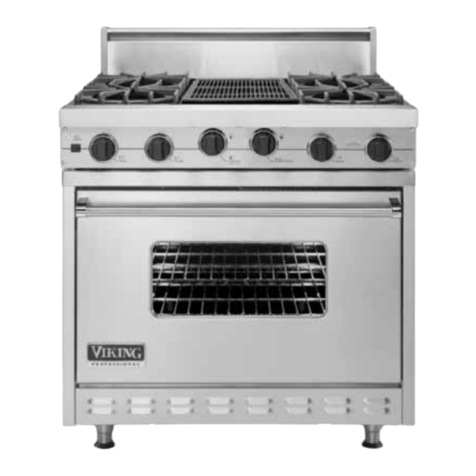
Viking
Viking VGRC365-4GD Series Specification sheet
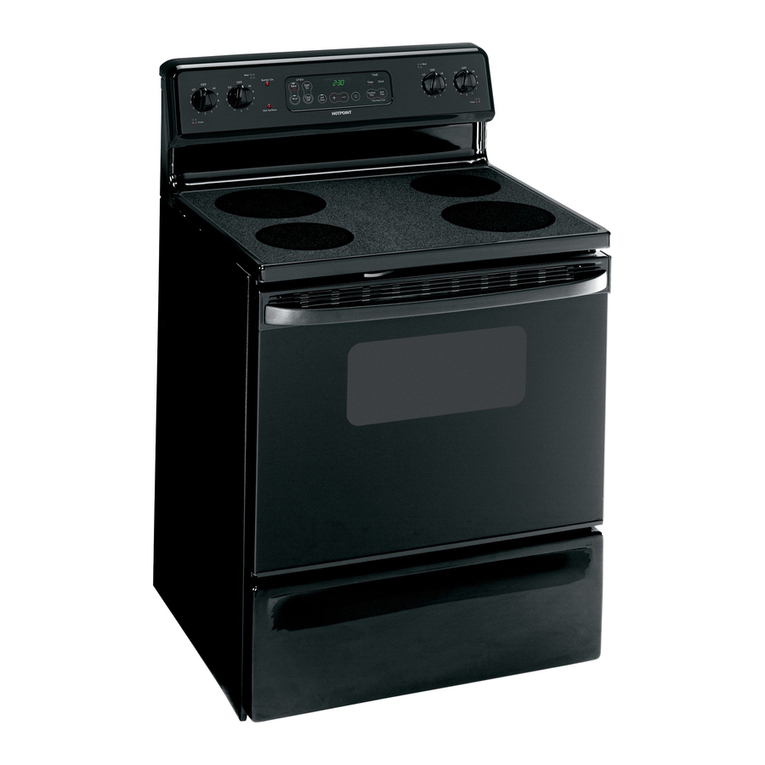
Hotpoint
Hotpoint RB787DPWW - Electric Range datasheet
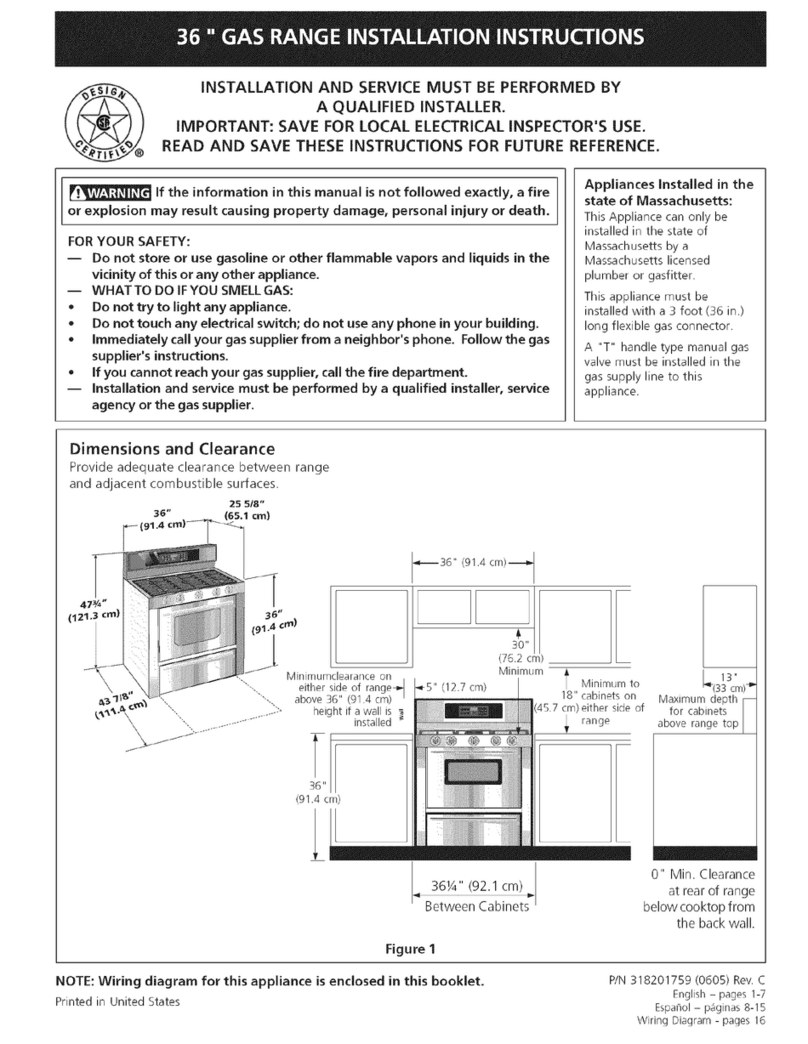
Kenmore
Kenmore 7540 - Elite 36 in. Gas installation instructions
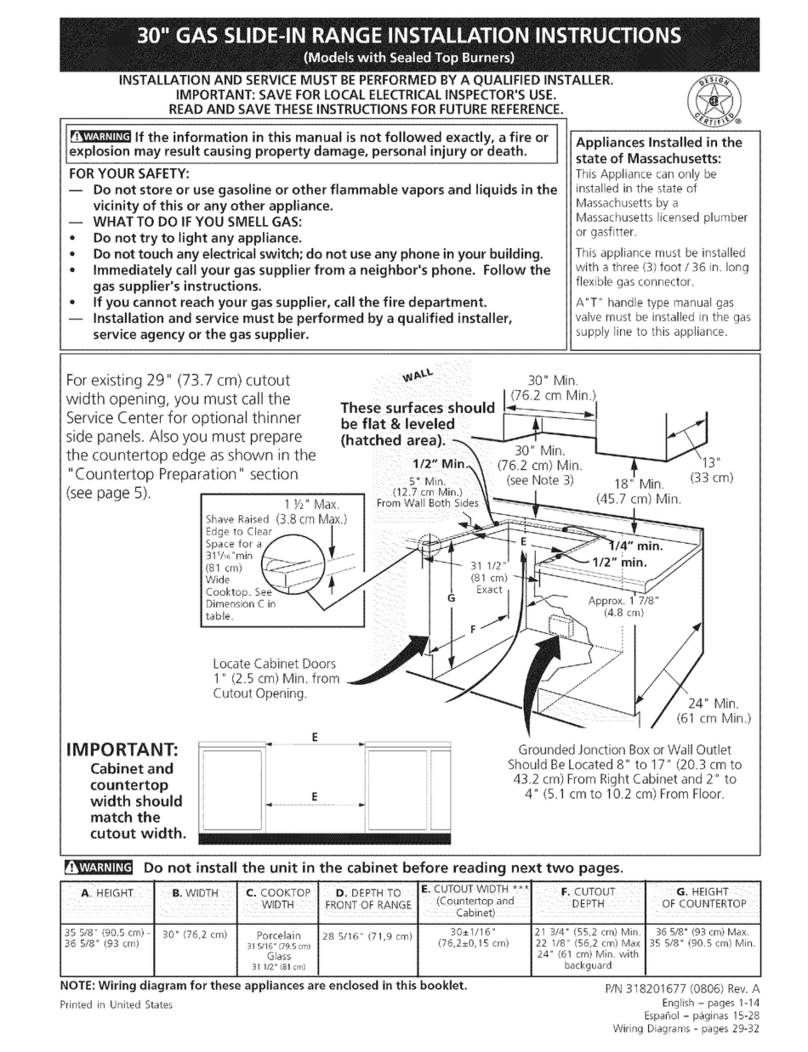
Kenmore
Kenmore 3103 - Elite 30 in. Slide-In Gas Range installation instructions




